Manon Puts Hal Ambro in Touch
As a continuing tribute to my friend Manon Washburn, here is the text of a letter from Harold (Hal) Ambro, Animator at Disney, Format, Hanna-Barbera and m0re. Manon did all the legwork to approach Hal on the job and ask him to write a letter to my Mother about my potential career in animation. He really came through and wrote quite a long letter, giving his opinions about the business, and about the kind of education he thought a young artist would need. Hal was a fellow St. Louisan, born there in 1913. He came to California in 1932 to study drawing, and wound up working for Charles Mintz on Scrappy and Color Rhapsodies, until he was employed by Walt Disney Productions in 1939. This letter was written about a year before he left Disney in 1966. After that he worked on many projects, such as “The Alvin Show” for Herb Klynn and many Hanna-Barbera projects, such as the feature “Heidi’s Song”, and some of the Scooby-Doo shows. I never got to know him well, said hello a few times. I saw him most often when he was working at the Sunset-Vine tower for Chuck Jones on “The White Seal”, “Mowgli’s Brothers” and “Rikki-Tikki-Tavi” in the 1970s.  Hal was a wonderful draftsman, as you can see by that appealing drawing of Wendy, above. He couldn’t really advance to “Nine Old Men” status at Disney, imagine the politics he had to navigate there to stay as long as he did! But like, Hal King, Bob Youngquist, Ken Hultgren and many other talents, he was a true Disney alumnus. Here’s the letter that maybe persuaded my Mother to think that animation wasn’t such a bad career choice after all:
Hal Ambro’s Letter to my Mother March 29 1965
Dear Mrs. Kausler,
It’s nice to hear about a young fellow who has decided what he wants to do. Animation as its used in Advertising Commercials will probably be around for a long time. The theatrical cartoon may someday cease to exist, due to high production costs.
Industrial and Educational films may replace the theatrical production, but here again cost is always important. Television may offer ways to help market animation features in the future.
As far as schooling goes, my opinion would be this; Training in layout, design, color, draftsmanship (figure and animal), Story ideas, would help to prepare one for a career in this field.
There are many ways to be a value in a small studio, and all the training you can get will be put to use, and you would be more valuable. The large Studio (Disney or Hannah(sic)-Barberra) still keep the work areas separated, i.e. animation dept., layout and background dept., Story dept., etc.
Any good art school that prepares you for advertising art would supply the necessary training. Chouinard is very fine school, Art Center in Los Angeles is an excellent Commercial Art and Industrial Design School. Chicago Art Institute I don’t know about, but undoubtedly is excellent.
The field of teaching, I think might offer some long range advantages. Teachers seem to have at least the prospect of good steady employment over the years. However I’m sure that in preparing for a teaching career in art, a student would necessarily have to study, if not produce the samples of fine arts. There is very little need for teachers in the animation industry.
Chouinard Institute has the qualified instructors as well as the University of So. California. So any teacher training would have to be in an academic art capacity and I’m sure there are many opportunities from the Elementary school level through the College level.
You asked about where I received my training. The only formal training I had was obtained at Art Center School in the early 1930 years. I went to night school and weekends to study figure drawing, composition. Even at that time the animation business was frowned upon by the Art Schools. The opportunities for a creative person, even now, may be far greater in possibly industrial design (designing of Automobiles, boats, packages, etc.) than the opportunities available in the animation field. And one thing I can vouch for, from 30 years of experience, is that the animation industry at the present time and for the past 5 years or so, has not been a growing business.
Regardless of the allure that surrounds the Disney Studio’s, their animation product is gradually diminishing in volume. The work force needed to-day at Disney’s to produce animation product is about 25% of what it used to be. This doesn’t mean that the artist can’t find a job there, but it does show that there are not many jobs available. This also means that the Studio can be very discriminating about the quality of the artist to-day and therefore it’s tougher to qualify. However, there are a few other studios (Playhouse and H-B notably). Playhouse, by the way, has had a practice of hiring the Animator on a free-lance basis. That means only when they have work, do they hire an animator. There is another aspect of this business that might present some possibilities, the ability to think up ideas for commercials and be able to present them in a graphic manner. By that I mean, draw up what I’ll call a story board and show just what the commercial will look like when its finished.
Actually, the ideas are the most important part of the commercial, so if Mark has a flair for ideas, he might find a spot in some Ad agency.
Educational T.V. may develop into a large field some day, but it hasn’t been exploited much up ‘til now. The cartoon industry in T.V. is limited to simple animations. The cost of productions and the time consumed in making a picture has put limitations on the T.V. cartoon product. As an example, “Rocky and his friends” (a T.V. weekly show of cartoons) (similar to Yogi Bear of H. & B. fame) is actually conceived and planned here, but animated and finished in Mexico City. And then after productions of any sort are finished, the producer re-sells the product 2 or 3 times. The H-B studio besides Disney is the only one that really keeps operating on a large scale, but even they are re-using material. I have worked on the “Alvin Show”, a cartoon show about 3 chipmunks, about 4 years ago. The “Alvin Show” is still being re-run. The T.V. networks buy these packages of pictures and keep selling them to advertising clients. Its smart business for the networks, but unfortunate for the cartoonists. This is why I personally feel that animated commercials, with all the ideas, story-boards, layout needs, and possible use of color, present the biggest opportunity to-day. This does not mean that opportunity is not in the theatrical cartoon, but I feel that advertising offers more. Even so the training one needs is the same for both fields.
If Mark has already been working with a commercial studio this is fine. He might find a valuable spot with that studio. He’s certainly getting a young start.
Well, I hope I have not thoroughly confused you with these thoughts on the business and as far as schooling goes, I really can’t say what is best. I know that to-day the versatility of one is important, so I feel that a well-rounded background of ideas, story-sketch ability, draftsmanship, layout or design, color, are equally needed.
Good luck in all your efforts, Mark and keep studying
Sincerely, Harold Ambro
Notably, Hal comments on the Disney studio’s decreasing volume of animation by 1965, and his hopes for the use of animation for education. It’s interesting that the prospects for employment in 1965 were so limited. Hal also makes a profound statement about TV series work when he says that the network’s ability to sell the same shows two or three times was “unfortunate for the cartoonists”. This was very true, especially when you consider that no cartoonist was paid any TV residuals, and had to be content with his hourly or piecework rate for the TV series work done. Both Manon and Hal were very hopeful about the use of animation for educational purposes. Of course, the reality of the situation was that most educational animated films were produced for a low price. Hugh Harman dabbled in them, but couldn’t produce much more that pose reels. Coronet films, Wilding Films and a few other companies made quite a few educational pictures, many of them being distributed on 16mm for schools and free loans, such as the Bell System Science Series, perhaps the best achievement in educational animation to date. That educational market has almost disappeared now for traditional animation, replaced by digital “animation”, such as Dr. Oz currently uses to show feces trapped in a colon (that’s entertainment)!
Hal became a teacher at Cal Arts in 1982, and passed away at his home in Woodland Hills in 1990.








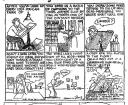

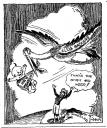
 Â We explore the L.A. Jr. Times from Sept. 1926 this time. It’s another tribute to Bob Wickersham and his funny animal strip “Fido Bark” from 9-5 to 9-26. There’s also a photo of Bob and Fido, and a strip by Bob’s friend Alex Perez about a visit to Bob’s house. Alex falls in love with Bob’s sister at first sight and tries to romance her through his comic strip! There’s also a Bill Zaboly cartoon about how a cartoonist submits work to the T.J.C.; Bill steals a bit from Clare Briggs here as he quotes “Ain’t It A Graaanndd and Glorious Feeeling!” There’s also a caricature of Manuel Moreno, an editorial cartoon by Frank Tipper and a comic strip by Larry Martin called “Billie Jean”, which he drew on 8-6-26.
 We explore the L.A. Jr. Times from Sept. 1926 this time. It’s another tribute to Bob Wickersham and his funny animal strip “Fido Bark” from 9-5 to 9-26. There’s also a photo of Bob and Fido, and a strip by Bob’s friend Alex Perez about a visit to Bob’s house. Alex falls in love with Bob’s sister at first sight and tries to romance her through his comic strip! There’s also a Bill Zaboly cartoon about how a cartoonist submits work to the T.J.C.; Bill steals a bit from Clare Briggs here as he quotes “Ain’t It A Graaanndd and Glorious Feeeling!” There’s also a caricature of Manuel Moreno, an editorial cartoon by Frank Tipper and a comic strip by Larry Martin called “Billie Jean”, which he drew on 8-6-26.







  Barker Bill this time consists of mostly “hat raising” spot gags that ran from 6-27 to 7-8-55. The 7-8 seems to be out of order, but I can’t read the date! It seems to be from the earlier stories about the Gelt. Little May is the subject of two strips this time.
 Barker Bill this time consists of mostly “hat raising” spot gags that ran from 6-27 to 7-8-55. The 7-8 seems to be out of order, but I can’t read the date! It seems to be from the earlier stories about the Gelt. Little May is the subject of two strips this time.






  Felix, from 8-19 to 8-25-1935, continues Felix’s exploration of the 5000 year old city he found on the Ape’s Island. He discovers a petrified bulldog and an ancient blow-gun. One of the sailors in the 8-23 is assigned to be a letter carrier back to the ship. What he anticipates to be an easy job is a hard haul because the letter is chiseled in 5000 year old stone! This gag anticipates the Fleischer “Stone Age” cartoons and of course, “The Flintstones” TV show. In the Sunday page, the little blond kid in the Bobby Dazzler topper resembles “Vontzy” from the Scrappy cartoons quite closely, in the main strip, Felix (still in Dreamland) helps a cop apprehend some burglars while he’s still asleep.
 Felix, from 8-19 to 8-25-1935, continues Felix’s exploration of the 5000 year old city he found on the Ape’s Island. He discovers a petrified bulldog and an ancient blow-gun. One of the sailors in the 8-23 is assigned to be a letter carrier back to the ship. What he anticipates to be an easy job is a hard haul because the letter is chiseled in 5000 year old stone! This gag anticipates the Fleischer “Stone Age” cartoons and of course, “The Flintstones” TV show. In the Sunday page, the little blond kid in the Bobby Dazzler topper resembles “Vontzy” from the Scrappy cartoons quite closely, in the main strip, Felix (still in Dreamland) helps a cop apprehend some burglars while he’s still asleep.





 Â Krazy, from 6-30 to 7-5-1941 is a six-part story about “blondeness”. You see, Krazy Kat gets her hair lightened in the Coconino Beauty Parlor, which causes a chain reaction of mistaken identity gags. In the 7-5, a little porter comes out of the Beauty Parlor with a blonde brick!
 Krazy, from 6-30 to 7-5-1941 is a six-part story about “blondeness”. You see, Krazy Kat gets her hair lightened in the Coconino Beauty Parlor, which causes a chain reaction of mistaken identity gags. In the 7-5, a little porter comes out of the Beauty Parlor with a blonde brick!
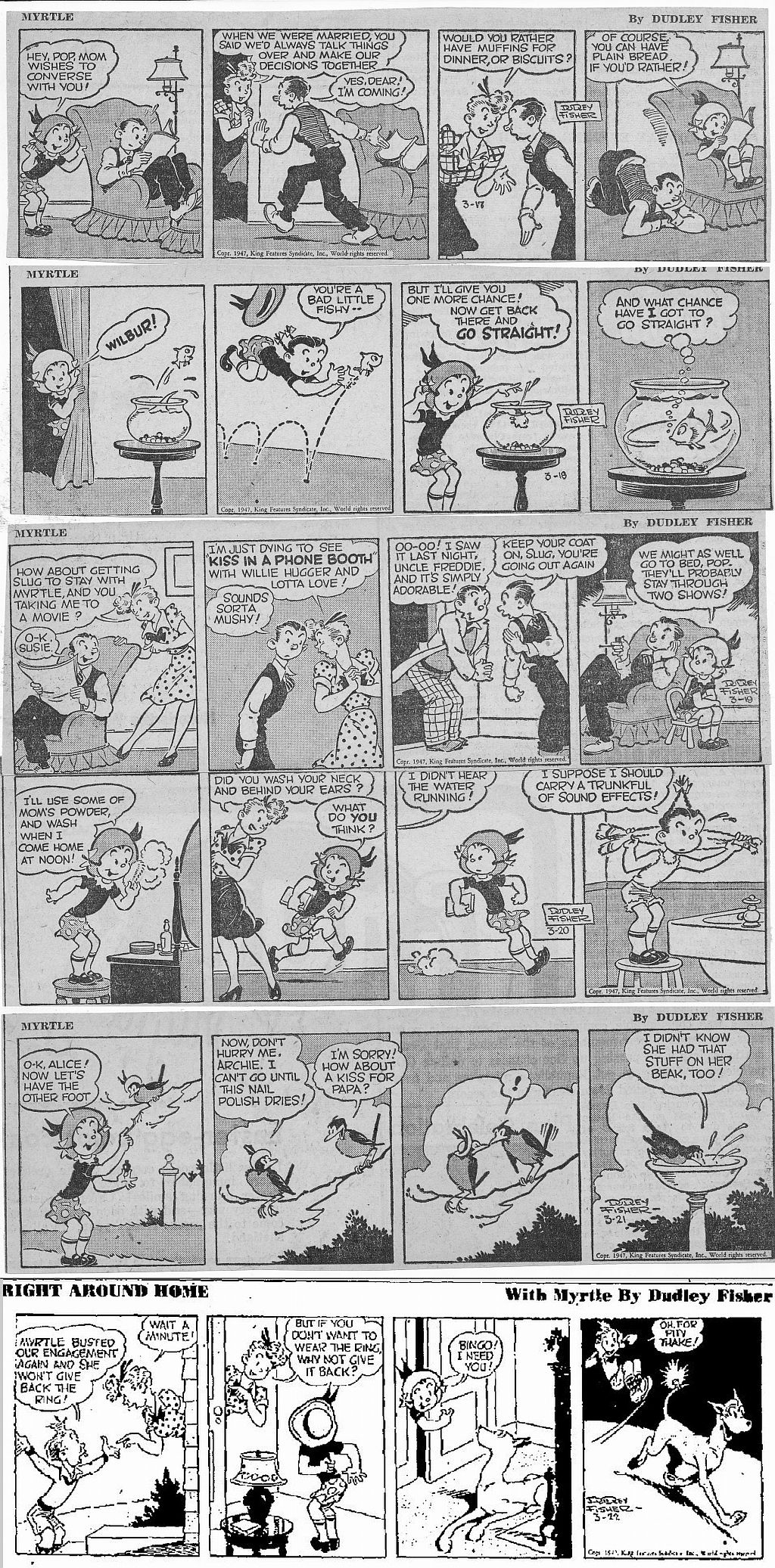 Â Dudley Fisher’s Myrtle this time is from 3-17 to 3-22-1947. I thought that Slug’s dialog in the third panel of the 3-19 was a real hoot, if you imagine him talking like Joe Besser. In the 3-20, there is a bit of a radio reference (radio drama was still big in 1947) as Myrtle says “I suppose I should carry a trunkful of sound effects!” In the 3-22 I like Sampson’s reaction to his ring winding up on Bingo’s tail, as he flys through the air in a big “take”.
 Dudley Fisher’s Myrtle this time is from 3-17 to 3-22-1947. I thought that Slug’s dialog in the third panel of the 3-19 was a real hoot, if you imagine him talking like Joe Besser. In the 3-20, there is a bit of a radio reference (radio drama was still big in 1947) as Myrtle says “I suppose I should carry a trunkful of sound effects!” In the 3-22 I like Sampson’s reaction to his ring winding up on Bingo’s tail, as he flys through the air in a big “take”.

 Â In anticipation of Yowp’s monthly dose of Yogi Bear Sunday pages, here are all the strips I have from July, 1962. They are from 7-22 and 7-29 respectively, the 7-22 might be the work of Gene Hazelton, note how Yogi keeps calling Boo-Boo, “Boo” throughout the strip. The 7-29 gag looks like Harvey Eisenberg’s work, especially the lettering on the mailbox and the Ranger’s sign, as well as the use of silhouette in the second panel. I know I’ve seen that “bees in the filing cabinet” joke before, but can’t remember where. Do any of you faithful readers recognize it?
 In anticipation of Yowp’s monthly dose of Yogi Bear Sunday pages, here are all the strips I have from July, 1962. They are from 7-22 and 7-29 respectively, the 7-22 might be the work of Gene Hazelton, note how Yogi keeps calling Boo-Boo, “Boo” throughout the strip. The 7-29 gag looks like Harvey Eisenberg’s work, especially the lettering on the mailbox and the Ranger’s sign, as well as the use of silhouette in the second panel. I know I’ve seen that “bees in the filing cabinet” joke before, but can’t remember where. Do any of you faithful readers recognize it?
And So Manon, Goodbye
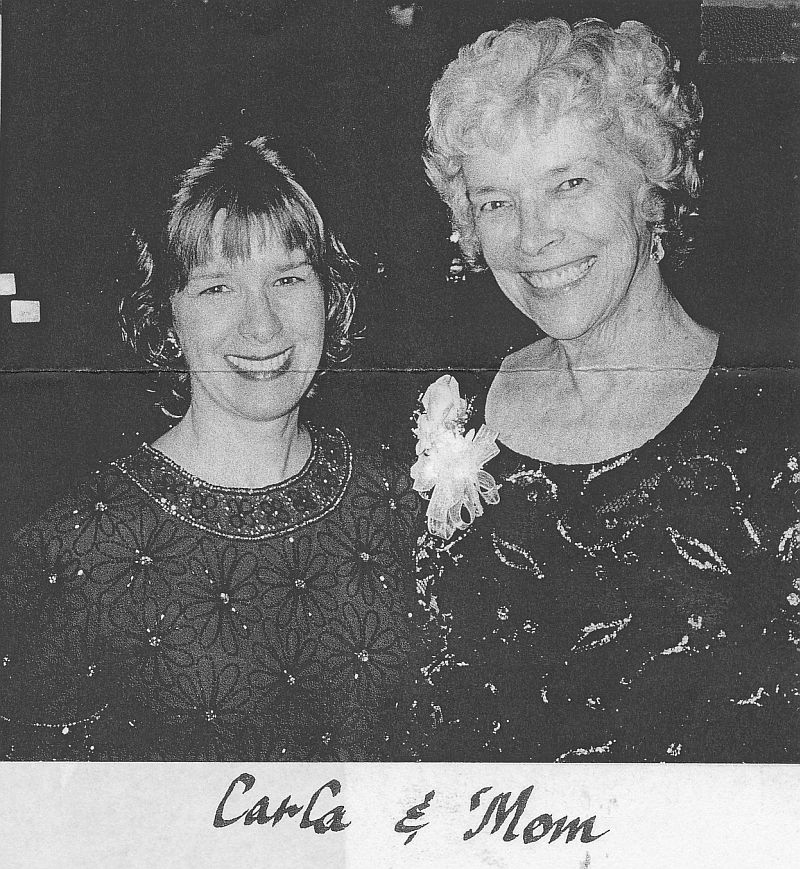 I learned Sunday Morning, June 24ththat my friend and mentor Manon Washburn had passed away as the result of a stroke the previous week (June 21st). Manon’s daughter Carla told me the news, above is a recent picture of Mother and Daughter from 2010.
I learned Sunday Morning, June 24ththat my friend and mentor Manon Washburn had passed away as the result of a stroke the previous week (June 21st). Manon’s daughter Carla told me the news, above is a recent picture of Mother and Daughter from 2010.
(In honor of Manon, no comics this post, all the cartoons are illustrations for the article. I have preserved most of Manon’s spelling and punctuation in the excerpts from her letters. Remember to click on the thumbnails to enlarge the pictures.)
You see, Manon was a very special childhood heroine of mine. Her first husband, Everett Washburn was a sheet metal worker who was employed at Curtis-Wright aircraft in California with my Dad Albert in the 1930s. Dad thought a great deal of Everett, they were good friends, and Everett told my dad that his wife was an inker in the animated cartoon business. I wrote to her, telling her of my great love for cartoons and desire to get into the business. Amazingly, she was not discouraging, but decidedly upbeat about it, a great contrast to my Mother’s attitude toward cartoons. We exchanged letters often, and she sent me many inked cels from commercials and TV shows she was working on, this was 1963 to 1967. She went out of her way to find animation artwork for me: Manon writing on March 12, 1964: I am really thrilled with one thing I am sending and am so very lucky to have gotten it. It is a complete story-board layout of one of the half-hour Flintstone shows. (TS-132 “Ladies Night Out At The Lodge”P-109) You yourself are really responsible for my getting it. You see, I have patiently approached one animator after another with your letter and begged for a crumb from their board. Some, as you know, are too busy to take much interest, others are pleased at your interest but don’t come up with anything—-and then there’s that one in a million who really knocks himself out because he has the capacity to appreciate what you are doing. This one I am talking about is an animator, a marvelous one, named Willie Ito (pronounced EETO). He is of Japanese descent I think but a real “way out kid” and what an artist! Well, anyhow, I told Willie about you (he works at Hanna-Barbera) and gave him your letter to read at his leasuire. He was charming and appeared both interested and impressed but I wasn’t sure about it until he handed me a huge folder full of loot!! He enclosed all kinds of production pictures beside the layout but told me he was sure you would get the most out of it because all the camera instructions are given on it and you would see all the terms that they use and how they indicate various things. I went through it carefully and was tempted to interpret such things as FX which means effects (sound, usually) but decided against it because I’m pretty sure you will understand it all without my help. I feel that you have enough background in animation to figure it out without difficulty. Of course, it goes without saying, that someone without your knowledge would not get the camera moves indicated and other strictly animation terms. (Among the drawings were several from the Magilla Gorilla Show main titles)
You yourself are really responsible for my getting it. You see, I have patiently approached one animator after another with your letter and begged for a crumb from their board. Some, as you know, are too busy to take much interest, others are pleased at your interest but don’t come up with anything—-and then there’s that one in a million who really knocks himself out because he has the capacity to appreciate what you are doing. This one I am talking about is an animator, a marvelous one, named Willie Ito (pronounced EETO). He is of Japanese descent I think but a real “way out kid” and what an artist! Well, anyhow, I told Willie about you (he works at Hanna-Barbera) and gave him your letter to read at his leasuire. He was charming and appeared both interested and impressed but I wasn’t sure about it until he handed me a huge folder full of loot!! He enclosed all kinds of production pictures beside the layout but told me he was sure you would get the most out of it because all the camera instructions are given on it and you would see all the terms that they use and how they indicate various things. I went through it carefully and was tempted to interpret such things as FX which means effects (sound, usually) but decided against it because I’m pretty sure you will understand it all without my help. I feel that you have enough background in animation to figure it out without difficulty. Of course, it goes without saying, that someone without your knowledge would not get the camera moves indicated and other strictly animation terms. (Among the drawings were several from the Magilla Gorilla Show main titles) 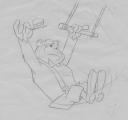 Do let me know if you are as pleased with it as I was. If you saw this particular Flintstone show, it will have even more meaning than otherwise. I always admired her ability with pen and brush on the unforgiving plastic ice pond known as a cel. She had such a delicate, supple fine line. Look at these examples from a Navy Recruiting spot produced at Playhouse Pictures.
Do let me know if you are as pleased with it as I was. If you saw this particular Flintstone show, it will have even more meaning than otherwise. I always admired her ability with pen and brush on the unforgiving plastic ice pond known as a cel. She had such a delicate, supple fine line. Look at these examples from a Navy Recruiting spot produced at Playhouse Pictures. 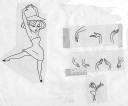 I especially like the hands and the cel with the tiny girl: On a visit to her house in 1963, she showed me several old cels from Leon Schlesinger cartoons of 1943. I remember she had one of Bugs Bunny, an early Elmer Fudd, and several others, all in that amazing fine line. She worked on “Hell-Bent For Election” at the fledgling UPA in 1944 when it was Industrial Film and Poster Service. This pro-Roosevelt film was right in line with her politics at the time. Manon worked on this picture with Martha Sigall, famed Schlesinger inker. Manon writing in 1964: It interested me very much when you said that the “great classics and animation were meant for each other”. I have always felt very strongly that as an educational medium, animation would have no equal. During the war (WWII), I worked on training films for the Army Air Force and I have never been able to forget the wonderful way animation can teach. (This was when Manon was with the First Motion Picture Unit in 1943. She’s to the extreme right of the photo-not politically.)
I especially like the hands and the cel with the tiny girl: On a visit to her house in 1963, she showed me several old cels from Leon Schlesinger cartoons of 1943. I remember she had one of Bugs Bunny, an early Elmer Fudd, and several others, all in that amazing fine line. She worked on “Hell-Bent For Election” at the fledgling UPA in 1944 when it was Industrial Film and Poster Service. This pro-Roosevelt film was right in line with her politics at the time. Manon worked on this picture with Martha Sigall, famed Schlesinger inker. Manon writing in 1964: It interested me very much when you said that the “great classics and animation were meant for each other”. I have always felt very strongly that as an educational medium, animation would have no equal. During the war (WWII), I worked on training films for the Army Air Force and I have never been able to forget the wonderful way animation can teach. (This was when Manon was with the First Motion Picture Unit in 1943. She’s to the extreme right of the photo-not politically.) A year or so ago, there was an hour long animated story on the sun on T.V. (“Our Mr. Sun”) It may have been made for a science class. It was expertly done and the (sometimes) dull scientific facts about the sun, its energy and what relation and effect it has on our lives was never more interestingly given. Here’s a few words about animation that Manon wrote in 1962, together with a wage breakdown for animation workers of the day:
A year or so ago, there was an hour long animated story on the sun on T.V. (“Our Mr. Sun”) It may have been made for a science class. It was expertly done and the (sometimes) dull scientific facts about the sun, its energy and what relation and effect it has on our lives was never more interestingly given. Here’s a few words about animation that Manon wrote in 1962, together with a wage breakdown for animation workers of the day:
One of the most intriguing things about animation is the liberty the animator has in interpreting a character (such as Walt Disney did with Mickey Mouse).I work on all the Burgie Beer commercials–he’s a very stylized little man. There’s a tremendous latitude between a drawing that almost is human and one that’s vastly simplified such as the Folger Coffee bean. I see no harm in Mark concentrating on what interests him most, that is animating a figure. There will always be artists who are only interested in drawing backgrounds. Most of the top people in the animation field have had four years of art school—not as many have had college art training because it usually isn’t as good. U.C.L.A. is, and there he would get the well-rounded education that is necessary in almost every intelligent field today. The top animators become storyboard layout men and for that you need a comprehensive education, psychology, philosophy, history, etc.
I see no harm in Mark concentrating on what interests him most, that is animating a figure. There will always be artists who are only interested in drawing backgrounds. Most of the top people in the animation field have had four years of art school—not as many have had college art training because it usually isn’t as good. U.C.L.A. is, and there he would get the well-rounded education that is necessary in almost every intelligent field today. The top animators become storyboard layout men and for that you need a comprehensive education, psychology, philosophy, history, etc.
The animation field is not too crowded. Highest in demand are the story-board and layout men. Each studio has only a few. Their weekly check is in the neighborhood of $500 a week. The top animators and background artists get between $250 (min.) and $450–etc. Assistant animators (just off the art school assembly line–) begin at $200 a week. Anim. Checkers make $150. Inkers, like myself, make $105. (take home $86) and painters make $90.
Despite the relatively low wages she earned, Manon was a hard worker and often took on two or three jobs at the same time to earn extra money.
Manon writing in August 1967: The Cartoon industry is still flourishing out here! Inkers are still at a premium. For almost two years now. I have been able to make more than a fourty hour check by simply taking work from more than one studio. Everything is still on the up-swing. New contracts and commercials, new animated series are all still very much with us. After I finished Charlie Brown All Stars for Bill Melendez, I went to work for Grant-Ray Lawrence who are putting out a series called Marvel Super Hero’s and out here it is on Sun. eves at 6pm for half an hour. It is limited animation and inking is just a matter of mouths, eyes, arms moving and loads of special effects! (guns blasting-rays-explosions, bullets conecting-etc.–it’s wild!)
Just last week, I also got some work from my favorite employer, Mary Cain, who you met. Disney is so busy with live action and other things–that he farmed out a commercial to Mary—So at last! I can say I have worked for Disney! I was careful to ink several of the cutest characters for you and I will paint them up and send them along! And you can say that Disney had to get his old animators to draw them, as the youngsters didn’t know how! It’s the real thing! Revived!
She did this overtime and free-lance practically all through her working life. Here, Manon gave me an idea of just how busy she could get: …my studio kept me very busy all through December. You should see me inking at my desk while the (neighbor’s) children build with the blocks on the rug beside me. If one knocks the other over the head with a block, Cathy (Manon’s daughter) dashes in to referee while I glance over occasionally to make sure blood isn’t flowing freely yet! As you can see from these sample cels, Manon could work with a wide variety of line styles, thick, thin, brush, pen or grease pencil.



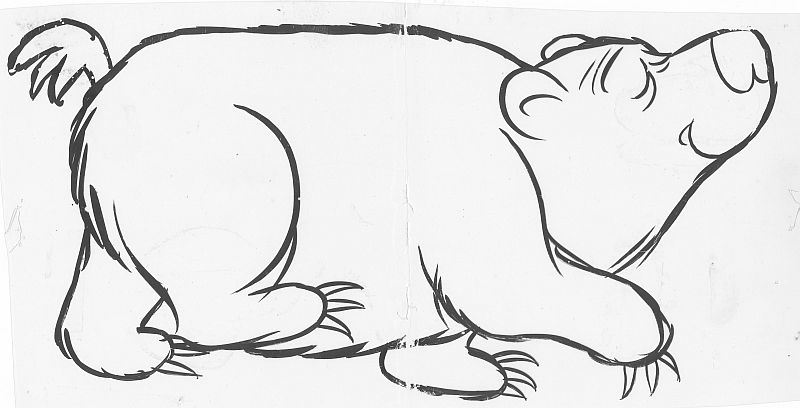 In 1966, Manon sent me a number of long Cinerama sized cels from the title sequence to “It’s a Mad, Mad, Mad, Mad World” which she traced onto the slippery plastic slopes with a grease pencil:
In 1966, Manon sent me a number of long Cinerama sized cels from the title sequence to “It’s a Mad, Mad, Mad, Mad World” which she traced onto the slippery plastic slopes with a grease pencil:
….I am sending some long cels in hopes you can cut them to size. They were rejections on “Mad, Mad World” because of scratches. I don’t think scratches show up on ordinary pictures, it was just that each cel was blown up ten feet and every speck of dust came through on the film. Also, I am sending some actual rejected sequences on “Mad World”. This is somewhat against my better judgement because you may find it worthless. I had to do the scene completely over because of scratches and I thought that either you would be interested in seeing the animation or that you could wash the cels off and re-use them. Let me know later on if you found any use for them. I’m still using them, Manon:

I visited the Washburns on my own in the summer of 1968, on vacation from Art School in Kansas City, intending to stay for two weeks. By the time I got out to Los Angeles, Everett and Manon were no longer married, but Everett lived about four blocks away from where Manon lived in Tujunga, so he put me up in a shed at the back of his house. I’ll never forget the first few nights I tried to sleep out there, so excited about cartoons and being so near to where they are made that I couldn’t close my eyes! While staying at Everett’s house, he taught me about Karl Marx and especially Marx’s predecessor, Georg Hegel. Everett was quite a serious, scholarly man who had very deep political beliefs. I got the feeling that Manon and Everett might have been attracted to each other partially from their political sensibilities. Manon could be a firebrand, being quite a critic of the war in Vietnam. She was in great favor of peace, we had quite a few discussions about that.
Manon made it possible for me to have a job, then a career in animated cartooning! She introduced me to Gary Mooney, who was animating a Green Giant commercial at Quartet Studio. He let me do a few inbetweens of the elves in the spot. They were no great beauties, but they were inkable. Here’s one of Gary’s roughs from that spot: I took the drawings into Filmation as samples; Hal Sutherland looked them over and said two words: “Start Monday”. I couldn’t drive, so I learned the bus route from Tujunga (where Manon lived) to Sherman Way in Reseda where Filmation was. I was in cartoon heaven working there, and met many old timers like Ruben Timmens and Virgil Ross. At last I wore out my welcome at Everett’s house (didn’t know enough about Hegel), and wound up bunking in the editing room of Fred Calvert’s studio in North Hollywood, which was a shorter bus ride to Filmation. I found myself working days at Filmation and nights at Fred Calvert’s, to earn my room. I would have worked 24 hours a day if I hadn’t needed sleep, I was just so excited to be doing professional work! I met Duane Crowther at Calvert’s, who became another mentor and great friend to me. All this happened because Manon introduced me to Gary Mooney.
I took the drawings into Filmation as samples; Hal Sutherland looked them over and said two words: “Start Monday”. I couldn’t drive, so I learned the bus route from Tujunga (where Manon lived) to Sherman Way in Reseda where Filmation was. I was in cartoon heaven working there, and met many old timers like Ruben Timmens and Virgil Ross. At last I wore out my welcome at Everett’s house (didn’t know enough about Hegel), and wound up bunking in the editing room of Fred Calvert’s studio in North Hollywood, which was a shorter bus ride to Filmation. I found myself working days at Filmation and nights at Fred Calvert’s, to earn my room. I would have worked 24 hours a day if I hadn’t needed sleep, I was just so excited to be doing professional work! I met Duane Crowther at Calvert’s, who became another mentor and great friend to me. All this happened because Manon introduced me to Gary Mooney.
I remember getting a lot of life lessons from Manon. I was pretty annoying and geeky when I got out to Los Angeles, (still am occasionally) and talked about cartoons almost all the time. Manon put up with it for quite awhile, but she eventually lost patience with my cartoon yammering. She let me know that even though she had been in the business since 1943, she didn’t really care for cartoons all that much. She was an artist, that happened to have the skill to work as an inker. She enjoyed the work to an extent, but it wasn’t a calling. (Later on, Manon taught watercolor painting, just look at her flowers and landscapes.) 
 I don’t think Manon ever told me exactly how she got started in the business, she was probably close to 21 when she started working. She also taught me to respect her as a lady, to open doors for her, and treat her gently. Not that I was rough on her, but I guess I thought of Manon as a fellow cartoon geek. I got wised up eventually.
I don’t think Manon ever told me exactly how she got started in the business, she was probably close to 21 when she started working. She also taught me to respect her as a lady, to open doors for her, and treat her gently. Not that I was rough on her, but I guess I thought of Manon as a fellow cartoon geek. I got wised up eventually.
Some years later, about 1972, I picked up a job from my friend Joe Adamson. He needed an animator to do a few scenes of Bugs Bunny for his independent short film, “A Political Cartoon”. I actually got a few lessons on how to draw Bugs from his best designer, Bob McKimson. When the drawings were finished, I immediately thought of Manon, who agreed to ink them. What a thrill to have an actual Warner Bros. inker doing my rabbits! I paid her as well as I could, and wound up with no money for the background painter, so I did them myself. I tried to save money on paint by using an old jar of Cartoon Colour rewettable white paint, which cracked and chipped in only a few years. This made the cels actually look much older than they actually were. That and Manon’s artistry made them more saleable as collectibles later on.
One of Manon’s good friends at Bill Melendez Studio was Bernard Gruver, a key layout and story board artist. Bernard thought the world of Manon, and often told me that her life stood for love, and she had a loving attitude to just about everybody. Here’s a birthday card that Bernard drew for Manon:
Manon writing on May 15, 1966: Now about things here in Hollywood. Bill Melendez broke with Playhouse Pix and went into business for himself. No, I did not work on the Charlie Brown Christmas Show, but I did see it. And I have worked on the new baseball show which has just gone to camera. It is called “Charlie Brown All Stars”, its about baseball and airs on June 8th. Please see it in color, if you can, you can’t really appreciate it in black and white. (1/2 hour show -full animation)
You will notice that the smaller studios (like Bill’s) always use inkers because on a small production the quality is more noticeable and more important. (An inker can interpret a character and impart a certain flavor.) The big studios are the only ones using Xerox that I know of–Disney–to be specific. Hanna Barbera are using a sort of grease pencil which goes faster than pen and is adequate for their multiple productions. I have worked on some Xerox for some pretty terrible (my opinion) low budget stuff. Inkers have to repair and register all Xerox. Without exception, all the commercials and shows which I have worked on have been inked. This year everything I have done has been in color. Animation comes across beautifully on color television and so much is being done in color now. Personally, I feel more full of hope than ever for animation and its marvelous possibilities for education, in spite of the poor material that has used this (our) medium thus far. I can’t help believing that not only will someone come along and do marvelous, top quality things in animation, but, that as a medium for education it will be fully utilized. Just because Disney has done so much with animation doesn’t mean he has exhausted the possibilities. (It’s interesting that color television was still such a remarkable novelty in 1966.)
Work is plentiful this year and the future looks bright.
Here are a few words that Manon wrote about the automation of the inking process (Xerox) which still ring true in the computer era: I fully agree with all you said on automation. In some places Xerox is replacing inkers but I cannot possibly imagine how it could replace animators. When that day comes and individual creative effort is eliminated it will be a sad commentary on the human race. Let’s have faith that we will never do that to ourselves. I do think that in many places in the world, people are not as barbaric as they used to be. But our scientific development is still way ahead of our social development. The great animator Grim Natwick came to nearly the same conclusion about scientific and social development when he was thinking about computer animation and electronic gadgets years later.
I had the great honor to speak for Manon in 2005, when she got her Golden Award for a lifetime in animation. Manon’s family, my wife Cathy and I were all there around her table at the Golden Awards banquet.  It was such a great night. It was an honor to see one of the good people, the inkers who never got enough credit for making animation drawings look good on the screen, receive this honor from her peers.
In her last years, I saw Manon less frequently. Her family expanded and she became a great-grandmother. Just look at that happy face with her grand-child Cove in 2011. That’s the way I like to remember Manon, that beaming happiness. All her children have that warm smile, it’s a family trademark. Her son, Conrad certainly has the family smile:
That’s the way I like to remember Manon, that beaming happiness. All her children have that warm smile, it’s a family trademark. Her son, Conrad certainly has the family smile:  I learned to respect Manon’s look of seriousness too, it meant she was thinking, and most of her thoughts were worth listening to. Her voice was breathy when she talked, almost a Marilyn Monroe inflection, but not as caricatured. She made friends easily, and never forgot a friend. Manon, I hope you will never be forgotten by your friends. Carla tells me that her Mom was alert, happy, teaching watercolor, dancing and active right up to the very end. Thanks, dear lady for all that you did for me. And so, Manon, Goodbye.
I learned to respect Manon’s look of seriousness too, it meant she was thinking, and most of her thoughts were worth listening to. Her voice was breathy when she talked, almost a Marilyn Monroe inflection, but not as caricatured. She made friends easily, and never forgot a friend. Manon, I hope you will never be forgotten by your friends. Carla tells me that her Mom was alert, happy, teaching watercolor, dancing and active right up to the very end. Thanks, dear lady for all that you did for me. And so, Manon, Goodbye.
(Any comments on Manon would be welcomed by her family. You can reach them at: yiayia.washburn@gmail.com . You are also welcome to comment here.)
Wick, Moreno and Larry Martin-Jr. Times August 1926

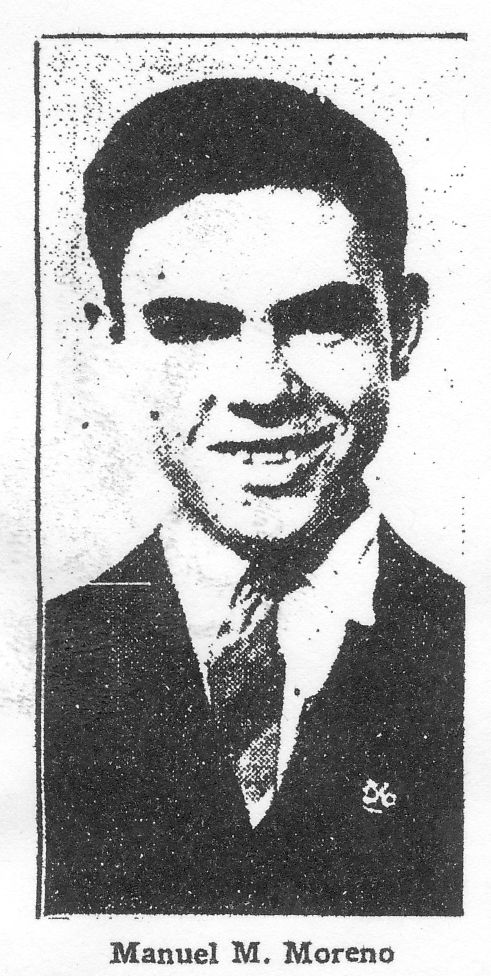 Â Here’s some more of Aunt Dolly’s boy cartoonists of August, 1926! That’s the great Harman-Ising animator Larry Martin’s cover to the 8-15-26 issue of the L.A. Junior Times, and a photo of the future animator, Manuel Moreno, from 8-1-26.
 Here’s some more of Aunt Dolly’s boy cartoonists of August, 1926! That’s the great Harman-Ising animator Larry Martin’s cover to the 8-15-26 issue of the L.A. Junior Times, and a photo of the future animator, Manuel Moreno, from 8-1-26.



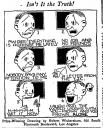
 Â A photograph of the future Thimble Theatre cartoonist, Bela “Bill” Zaboly from 8-8-26 appears above. At this point Bela was living in Cleveland, Ohio and promoting the T.J.C. to the populace with hand-drawn posters. We continue the reprint of Bob Wickersham’s funny animal strip, Fido Bark, from 8-1 to 8-29-26. In the 8-8-26 strip, Fido visits Al Perez’s studio. Al was another Aunt Dolly discovery. A talented cartoonist, Al did comics and decorative work for the Jr. Times. I found two of Wick’s T.J.C. promo cartoons from 8-8 and 8-15-26, which originally appeared on “Aunt Dolly’s Page”. To round it off, the only episode of Manuel Moreno’s “Keen and Feeble Tat” that ran in August is included. By this time, Moreno was already into his professional career, and was drawing fewer strips for the Junior Times. Have any of you readers ever SEEN an actual newspaper copy of the Junior Times? Supposedly, the Boy Cartoonists’s work appeared in color. The pages seem to have been five columns wide.
 A photograph of the future Thimble Theatre cartoonist, Bela “Bill” Zaboly from 8-8-26 appears above. At this point Bela was living in Cleveland, Ohio and promoting the T.J.C. to the populace with hand-drawn posters. We continue the reprint of Bob Wickersham’s funny animal strip, Fido Bark, from 8-1 to 8-29-26. In the 8-8-26 strip, Fido visits Al Perez’s studio. Al was another Aunt Dolly discovery. A talented cartoonist, Al did comics and decorative work for the Jr. Times. I found two of Wick’s T.J.C. promo cartoons from 8-8 and 8-15-26, which originally appeared on “Aunt Dolly’s Page”. To round it off, the only episode of Manuel Moreno’s “Keen and Feeble Tat” that ran in August is included. By this time, Moreno was already into his professional career, and was drawing fewer strips for the Junior Times. Have any of you readers ever SEEN an actual newspaper copy of the Junior Times? Supposedly, the Boy Cartoonists’s work appeared in color. The pages seem to have been five columns wide.







 Â Here’s Barker Bill from 6-13 to 6-23-1955. Newton Mommisboy continues his pursuit of Barker Bill’s Mermaid, only to discover that she’s a fraud! A new story with Puddy starts on 6-22. By this time, I’ve only been able to find 4 out of the 6 dailies for each week. If any one has the missing dailies, please write to me.
 Here’s Barker Bill from 6-13 to 6-23-1955. Newton Mommisboy continues his pursuit of Barker Bill’s Mermaid, only to discover that she’s a fraud! A new story with Puddy starts on 6-22. By this time, I’ve only been able to find 4 out of the 6 dailies for each week. If any one has the missing dailies, please write to me.






 Â Felix is from 8-12 to 8-18-1935, continuing Felix’s hunt for a lost civilization on the Ape’s Island. He goes from a scapegoat in the 8-12, to a hero in the 8-17, when Felix actually digs up an ancient sunken city in the quest for a place to rest! In the Sunday, Felix helps a Jiggs-like man to get out of the house for an evening, if only in his dreams!
 Felix is from 8-12 to 8-18-1935, continuing Felix’s hunt for a lost civilization on the Ape’s Island. He goes from a scapegoat in the 8-12, to a hero in the 8-17, when Felix actually digs up an ancient sunken city in the quest for a place to rest! In the Sunday, Felix helps a Jiggs-like man to get out of the house for an evening, if only in his dreams!





 Â Krazy is from 6-23 to 6-28-1941 this time. Not much continuity, except for 6-26 and 6-27, where Krazy fools a swami mind-reader by thinking in “Eskimo”, sort of forshadowing the use of the Navajo language for code during World War II.
 Krazy is from 6-23 to 6-28-1941 this time. Not much continuity, except for 6-26 and 6-27, where Krazy fools a swami mind-reader by thinking in “Eskimo”, sort of forshadowing the use of the Navajo language for code during World War II.
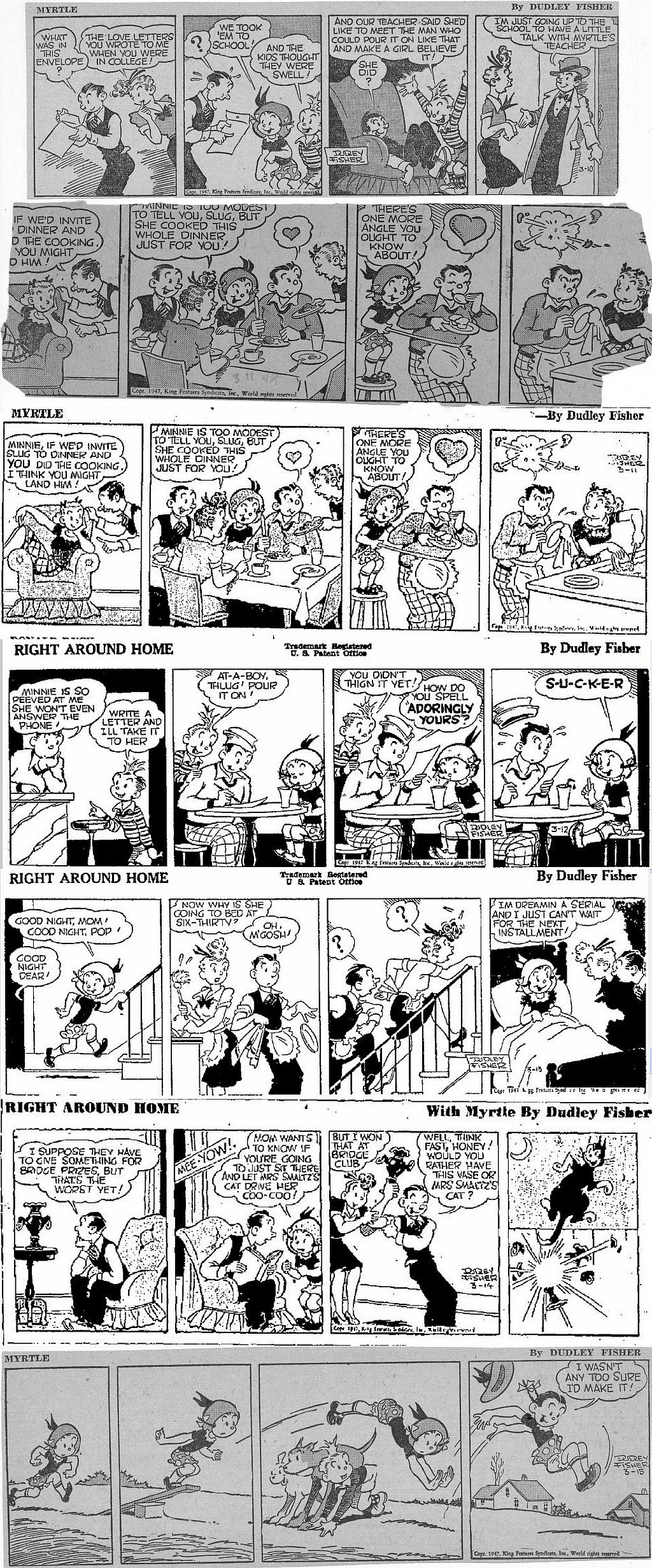 Â Myrtle is from 3-10 to 3-15-1947 in this batch. My newspaper run was short by 3 1/2 strips, so I found the missing ones over at Newspaper Archive. My favorite Fisher Frolic this time is the 3-15 strip. Note in the third and fourth panel how Fisher links the action as Myrtle tumbles over the dogs and Sampson. The speed lines from Myrtle’s hands overlap the panel border, giving a real feel of continuous animation to her tumbling act. It was my brother’s idea to fill in the missing Myrtle strips, which, despite the variance in quality, I think is a good one. Let me know if any of you have actual Junior Times issues, and we’ll see you again soon.
 Myrtle is from 3-10 to 3-15-1947 in this batch. My newspaper run was short by 3 1/2 strips, so I found the missing ones over at Newspaper Archive. My favorite Fisher Frolic this time is the 3-15 strip. Note in the third and fourth panel how Fisher links the action as Myrtle tumbles over the dogs and Sampson. The speed lines from Myrtle’s hands overlap the panel border, giving a real feel of continuous animation to her tumbling act. It was my brother’s idea to fill in the missing Myrtle strips, which, despite the variance in quality, I think is a good one. Let me know if any of you have actual Junior Times issues, and we’ll see you again soon.
Yowp Asked For It
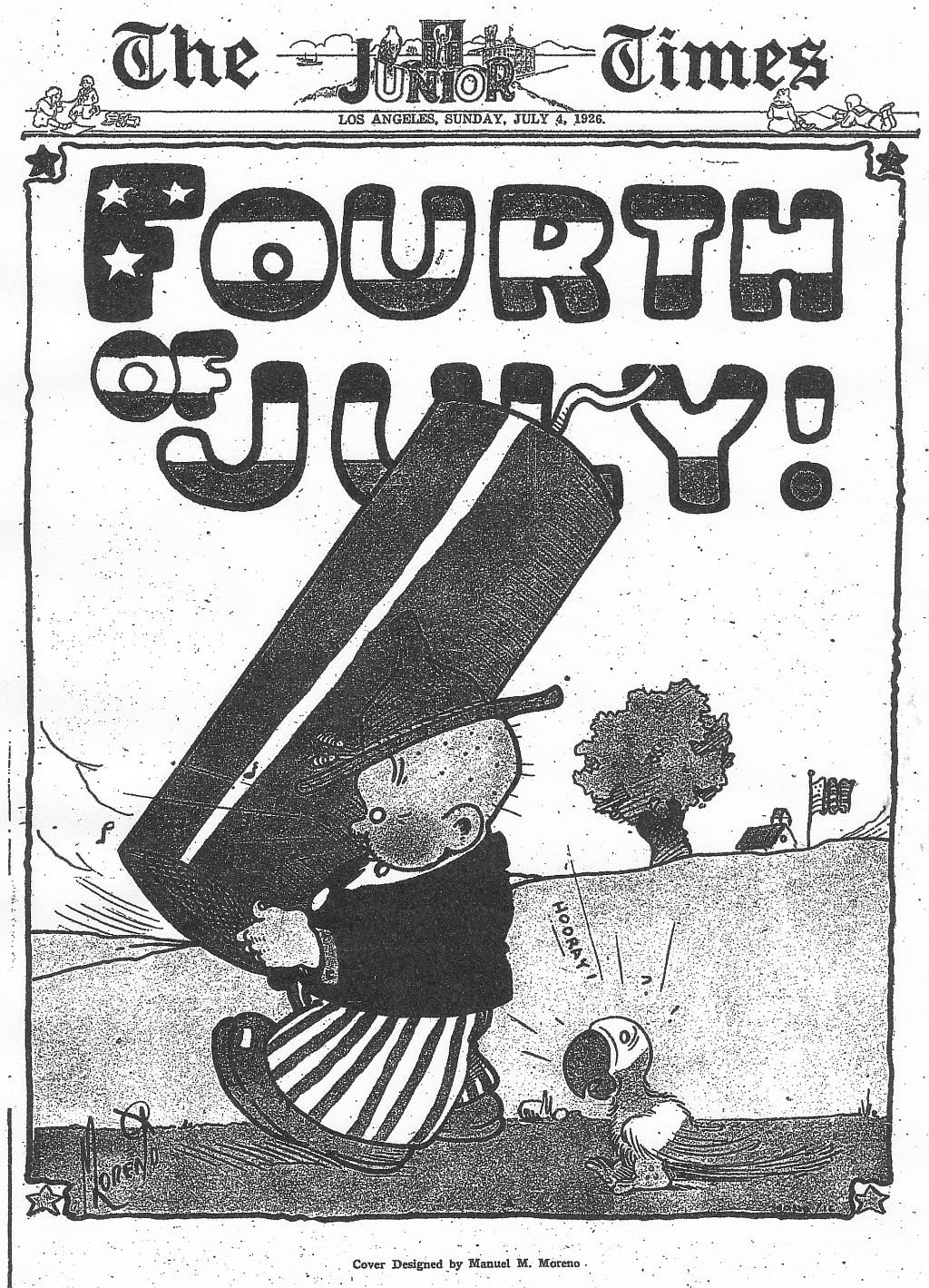








  I’m posting again so soon, because it’s that time of the month. Yowp has posted a new batch of Yogi Bear Sunday pages on his website (link in the blogroll to the left). Therefore, I will contribute my versions at the bottom of this post. At the top, you will find more material from the L.A. Jr. Times, July, 1926. A cover for the July 4th issue by Manuel Moreno and three more “Keen and Feeble Tat” strips, plus a collection of spot gag panels that Manuel contributed as space filler for the Jr. Times. There are two more “Fido Bark” strips by Bob Wickersham, a couple of Fred Moore kid strips and a strip by Frank Tipper called “The Average Home” from 7-26.
 I’m posting again so soon, because it’s that time of the month. Yowp has posted a new batch of Yogi Bear Sunday pages on his website (link in the blogroll to the left). Therefore, I will contribute my versions at the bottom of this post. At the top, you will find more material from the L.A. Jr. Times, July, 1926. A cover for the July 4th issue by Manuel Moreno and three more “Keen and Feeble Tat” strips, plus a collection of spot gag panels that Manuel contributed as space filler for the Jr. Times. There are two more “Fido Bark” strips by Bob Wickersham, a couple of Fred Moore kid strips and a strip by Frank Tipper called “The Average Home” from 7-26.










 Â Here’s Barker Bill, from 5-30 to 6-9-1955. I’ve included the black and white version of the Sunday page we ran last time in color, which proves that the page appeared in 1955, not 1950. Sorry Ger! The “Puddy’s Coronation” story ends on 6-7, as Puddy tries to put his kingdom of Screwbalia on the “Bone Standard” as a monetary value. It nearly causes a revolution, driving Puddy and the Circus back to the States. On 6-8, the story of Newton Mommisboy, reporter, starts as Newton tries to interview a Mermaid who is part of Barker Bill’s circus. On June 5th, the Boston Globe dropped the Barker Bill strip, so the rest of the ones I have come from The Greensburg Daily Tribune, which only ran the daily four days a week. I think we can still tell what’s going on, however, the Greensburg paper’s Google News Archive collection is not as sharp as the ProQuest Boston Globe.
 Here’s Barker Bill, from 5-30 to 6-9-1955. I’ve included the black and white version of the Sunday page we ran last time in color, which proves that the page appeared in 1955, not 1950. Sorry Ger! The “Puddy’s Coronation” story ends on 6-7, as Puddy tries to put his kingdom of Screwbalia on the “Bone Standard” as a monetary value. It nearly causes a revolution, driving Puddy and the Circus back to the States. On 6-8, the story of Newton Mommisboy, reporter, starts as Newton tries to interview a Mermaid who is part of Barker Bill’s circus. On June 5th, the Boston Globe dropped the Barker Bill strip, so the rest of the ones I have come from The Greensburg Daily Tribune, which only ran the daily four days a week. I think we can still tell what’s going on, however, the Greensburg paper’s Google News Archive collection is not as sharp as the ProQuest Boston Globe.






 Â Felix, from 8-5 to 8-11-1935 continues the story of the expedition to the Ape’s Island. Danny is rounded up, and Felix discovers an ancient Chinese jar that’s twenty thousand years old. They sure made jars to last! In the Sunday, Felix cures a man of his superstitious fear of black cats by giving him dreams. I love the design of the black cat that Felix rescues! Pure Messmer magic!
 Felix, from 8-5 to 8-11-1935 continues the story of the expedition to the Ape’s Island. Danny is rounded up, and Felix discovers an ancient Chinese jar that’s twenty thousand years old. They sure made jars to last! In the Sunday, Felix cures a man of his superstitious fear of black cats by giving him dreams. I love the design of the black cat that Felix rescues! Pure Messmer magic!





 Â Krazy, from 6-14 to 6-21-1941, features several strips based on songs that Krazy loves to sing. See if you remember them.
 Krazy, from 6-14 to 6-21-1941, features several strips based on songs that Krazy loves to sing. See if you remember them.
  Myrtle is from 3-3 to 3-8-1947. Bingo is featured in the 3-5 and 3-8. Note the human position of Bingo’s right front leg in the 3-8, as he rests his chin on his paw. Dudley Fisher did an effective balancing act of human and canine attitudes in his dog characters, working them on both levels. Occasionally, Myrtle and Sampson can have “conversations” with Bingo and Hyacinth, as you will see.
 Myrtle is from 3-3 to 3-8-1947. Bingo is featured in the 3-5 and 3-8. Note the human position of Bingo’s right front leg in the 3-8, as he rests his chin on his paw. Dudley Fisher did an effective balancing act of human and canine attitudes in his dog characters, working them on both levels. Occasionally, Myrtle and Sampson can have “conversations” with Bingo and Hyacinth, as you will see.
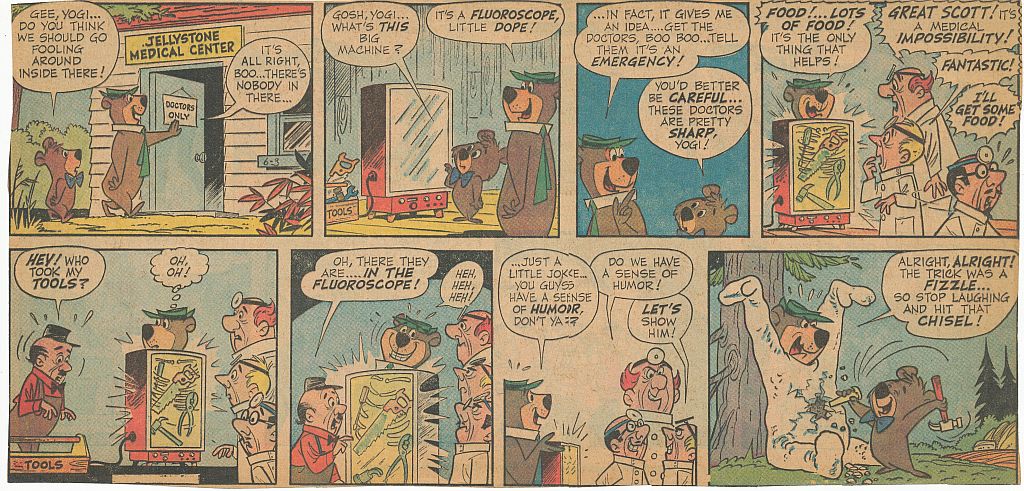


  Now we’ve come to the reason for this post, the color versions of the Yogi Bear Sundays from 6-3 to 6-24-1962. As you see, they are not half-page, but third-page versions. The Bloom was off the Bear by 1962 as far as the St. Louis Post-Dispatch was concerned, and they demoted Yogi by running him as a third-page feature. Yogi eventually switched to the St. Louis Globe-Democrat which restored the half-page Yogi, those will be coming up next time. Yowp has these strips at the half-page size on his latest post, so go over there to read the missing top row of panels. Most of the art on these is by Harvey Eisenberg, and Doggie Daddy (called “Augie Daddy” in the strip) makes a guest shot in the 6-17. Sorry for the haste in slapping this post together, we’ll do better next time.
 Now we’ve come to the reason for this post, the color versions of the Yogi Bear Sundays from 6-3 to 6-24-1962. As you see, they are not half-page, but third-page versions. The Bloom was off the Bear by 1962 as far as the St. Louis Post-Dispatch was concerned, and they demoted Yogi by running him as a third-page feature. Yogi eventually switched to the St. Louis Globe-Democrat which restored the half-page Yogi, those will be coming up next time. Yowp has these strips at the half-page size on his latest post, so go over there to read the missing top row of panels. Most of the art on these is by Harvey Eisenberg, and Doggie Daddy (called “Augie Daddy” in the strip) makes a guest shot in the 6-17. Sorry for the haste in slapping this post together, we’ll do better next time.
By the way, there are new frame grabs from “There Must Be Some Other Cat” over at Itza Cat’s Facebook page: www.facebook.com/someothercat . So head over there, become Itza’s friend. He’d love to get a tummy rub while you’re at it.
Moreno and Wick 6-1926 Jr. Times!






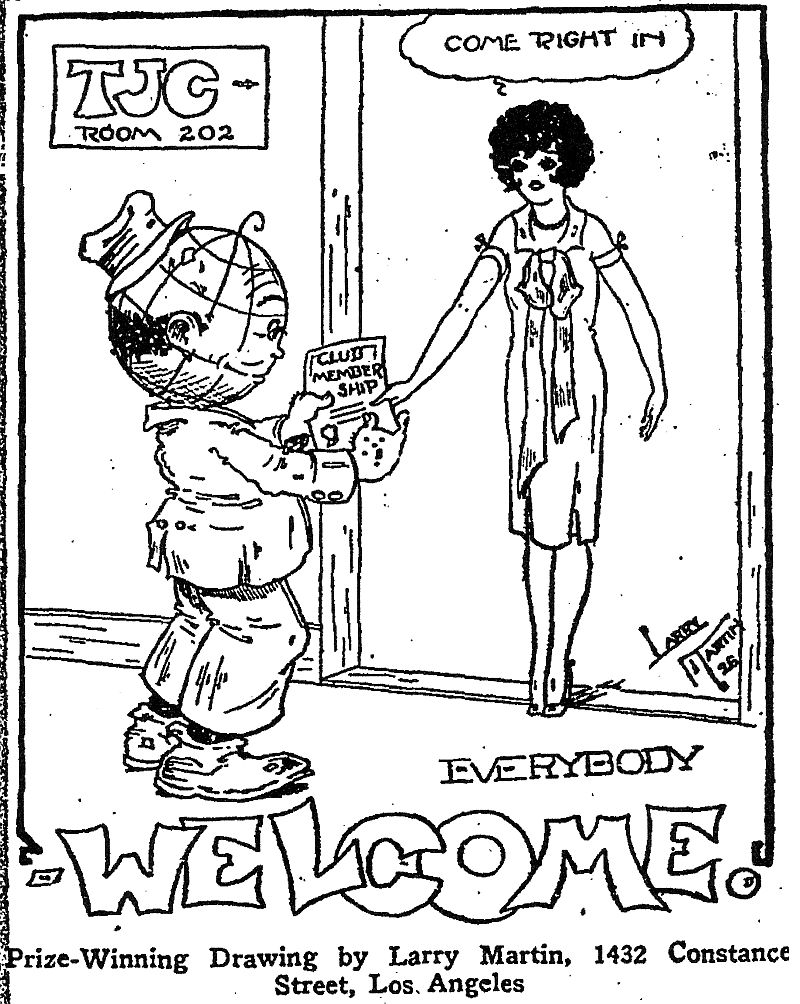  Here’s some strips from the L.A. Junior Times from June 6th to the 27th, 1926. I heard from Mario Manuel Prietto, Manuel Moreno’s grandson! In honor of that letter, I’m putting up a whole month’s worth of Manuel’s Jr. Times Comic Strip. Go back a few posts to : “Introducing the L.A. Jr. Times, 1922-23” to read Mario’s letter. He filled me in on some very interesting details of Manuel’s production efforts in Mexico in the 1940s. I still don’t know if the mysterious “Tat” of “Tat’s Tales” studio is Manuel or not. He used the title “Keen and Feeble Tat” in his ongoing strip for the Jr. Times in 1926. You’ll note that Feeble visits Fred Richards’s studio in the 6-13 entry, one of Mario’s fellow Jr. Times cartoonists. Manuel has a pretty mature sense of gags for a youngster, and he always tacks on an extra: “Today’s Can of T.N.T.” at the end of each strip. Bob Wickersham’s Fido Bark continues as Fido gets lost in the African jungles. It’s amusing that so many of the kids used the “world travelling” or “African Explorer” plotlines in crafting their strips. This was a good ploy to make sure that the kid cartoonist would find their strip (and check for $2.50) in the Jr. Times each week. Finally, Aunt Dolly said that she would accept no more “Continued Stories” with “Bad Grammar” in the Jr. Times, but this did nothing to abate the tide of chapter plays (the grammar did improve a bit). Last we have Larry Martin’s panel cartoon of 6-27-26 featuring the World applying for T.J.C. membership from a very glamorous Aunt Dolly! I wonder if she was really that fetching? Her columns in the Jr. Times indicate a very worldly lady with a big heart, who lived a rough life in the Wild West before she settled in Los Angeles. Aunt Dolly should be better known to all of us, she made it possible for a whole generation of cartoonists and animators to get started on their careers.
 Here’s some strips from the L.A. Junior Times from June 6th to the 27th, 1926. I heard from Mario Manuel Prietto, Manuel Moreno’s grandson! In honor of that letter, I’m putting up a whole month’s worth of Manuel’s Jr. Times Comic Strip. Go back a few posts to : “Introducing the L.A. Jr. Times, 1922-23” to read Mario’s letter. He filled me in on some very interesting details of Manuel’s production efforts in Mexico in the 1940s. I still don’t know if the mysterious “Tat” of “Tat’s Tales” studio is Manuel or not. He used the title “Keen and Feeble Tat” in his ongoing strip for the Jr. Times in 1926. You’ll note that Feeble visits Fred Richards’s studio in the 6-13 entry, one of Mario’s fellow Jr. Times cartoonists. Manuel has a pretty mature sense of gags for a youngster, and he always tacks on an extra: “Today’s Can of T.N.T.” at the end of each strip. Bob Wickersham’s Fido Bark continues as Fido gets lost in the African jungles. It’s amusing that so many of the kids used the “world travelling” or “African Explorer” plotlines in crafting their strips. This was a good ploy to make sure that the kid cartoonist would find their strip (and check for $2.50) in the Jr. Times each week. Finally, Aunt Dolly said that she would accept no more “Continued Stories” with “Bad Grammar” in the Jr. Times, but this did nothing to abate the tide of chapter plays (the grammar did improve a bit). Last we have Larry Martin’s panel cartoon of 6-27-26 featuring the World applying for T.J.C. membership from a very glamorous Aunt Dolly! I wonder if she was really that fetching? Her columns in the Jr. Times indicate a very worldly lady with a big heart, who lived a rough life in the Wild West before she settled in Los Angeles. Aunt Dolly should be better known to all of us, she made it possible for a whole generation of cartoonists and animators to get started on their careers.












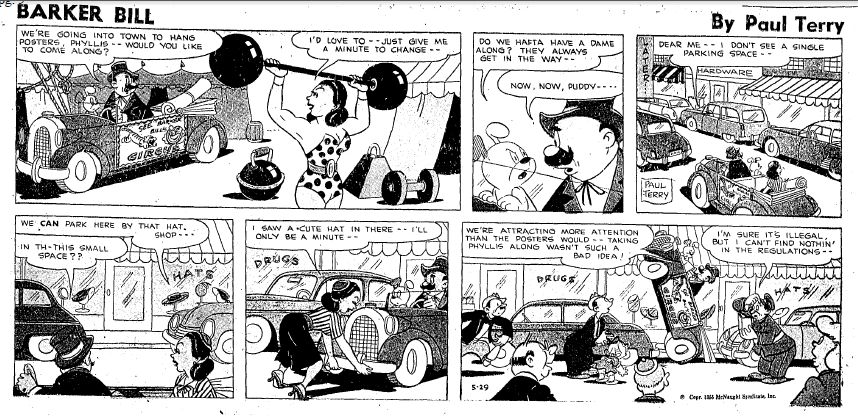
 Â Make sure you visit Allan Holtz’s Stripper’s Guide blog this week for some great posts on the history of Bob Kuwahara, including some of his extremely rare “Miki” strip! In Bob’s Barker Bill this time, we wind up the story of “Floating Bill”, as Ali K. Zam buys the spell which will bring Bill back to Earth. In the 5-21-55 episode, Bill meets Count Yuhchange from the kingdom of Screwbalia. He wants Puddy to be the King of Screwbalia because he can talk! Puddy takes the entire Barker Bill Circus to Screwbalia with him on one airplane (they’ll never get it off the ground). Puddy learns to his surprise that he is to have a Queen! This reminds me a lot of “Puddy’s Coronation”, which Castle Films released as “Hail the King”. The Sundays this time are from 5-29 and 6-5-1950(?). The color Sunday page was supplied by our reader Ger Apeldoorn, who claims the 1950 date. Since the first Barker Bill didn’t appear until 9-27-1954, I would vote for a 1955 date for this page. I’m really happy to have a color Bill Sunday page, thanks Ger! Go to Ger’s blog for more comics than you’ll ever have time to read. It’s called “The Fabulous Fifties” and there is a link over on the Blogroll.
 Make sure you visit Allan Holtz’s Stripper’s Guide blog this week for some great posts on the history of Bob Kuwahara, including some of his extremely rare “Miki” strip! In Bob’s Barker Bill this time, we wind up the story of “Floating Bill”, as Ali K. Zam buys the spell which will bring Bill back to Earth. In the 5-21-55 episode, Bill meets Count Yuhchange from the kingdom of Screwbalia. He wants Puddy to be the King of Screwbalia because he can talk! Puddy takes the entire Barker Bill Circus to Screwbalia with him on one airplane (they’ll never get it off the ground). Puddy learns to his surprise that he is to have a Queen! This reminds me a lot of “Puddy’s Coronation”, which Castle Films released as “Hail the King”. The Sundays this time are from 5-29 and 6-5-1950(?). The color Sunday page was supplied by our reader Ger Apeldoorn, who claims the 1950 date. Since the first Barker Bill didn’t appear until 9-27-1954, I would vote for a 1955 date for this page. I’m really happy to have a color Bill Sunday page, thanks Ger! Go to Ger’s blog for more comics than you’ll ever have time to read. It’s called “The Fabulous Fifties” and there is a link over on the Blogroll.






 Â In Felix, 7-29 to 8-4-1935, Danny once again gets lost, this time in a cave (7-31). There is an odd story gap from between 8-1 and 8-2 as a charging hippo gets mixed up in the continuity. Maybe Otto fell asleep at his desk that day. In the Sunday, Felix controls a boxing match from Dreamland. I think Otto might have been a fight fan, judging from the “Socky” character in the 1936 Felix strip. You can find his adventures in the blog Archive.
 In Felix, 7-29 to 8-4-1935, Danny once again gets lost, this time in a cave (7-31). There is an odd story gap from between 8-1 and 8-2 as a charging hippo gets mixed up in the continuity. Maybe Otto fell asleep at his desk that day. In the Sunday, Felix controls a boxing match from Dreamland. I think Otto might have been a fight fan, judging from the “Socky” character in the 1936 Felix strip. You can find his adventures in the blog Archive.





  In “K” this time from 6-9 to 6-14-1941, the theme is “Big and Little”. I love the giant Ignatz in the 6-10. There is a flea circus on Krazy’s back in the 6-12 and 6-13. I had to get the 6-12 episode from Newspaper Archive, so it is not the same quality as the others. Note the rabbit design in the 6-14, sort of like a cousin of Oswald.Â
 In “K” this time from 6-9 to 6-14-1941, the theme is “Big and Little”. I love the giant Ignatz in the 6-10. There is a flea circus on Krazy’s back in the 6-12 and 6-13. I had to get the 6-12 episode from Newspaper Archive, so it is not the same quality as the others. Note the rabbit design in the 6-14, sort of like a cousin of Oswald.Â
  In Myrtle this time from 2-24 to 3-1-1947, most of the week is taken up with Myrtle’s phony diamond ring. You will note in the 2-28 how Myrtle’s punishment is to stand in the corner, sort of a “time-out” in modern parlance. Once in a while Myrtle endures corporal punishment ala Little Lulu, but there is a slightly more liberal, loving atmosphere in the way Myrtle is being raised by her parents. They are quite tolerant of Myrtle’s high spirits, just look at the way she springs through the front door in the 2-26! Well, this blog has taken too much time once again. See you after Yowp puts up a new batch of Yogis.
 In Myrtle this time from 2-24 to 3-1-1947, most of the week is taken up with Myrtle’s phony diamond ring. You will note in the 2-28 how Myrtle’s punishment is to stand in the corner, sort of a “time-out” in modern parlance. Once in a while Myrtle endures corporal punishment ala Little Lulu, but there is a slightly more liberal, loving atmosphere in the way Myrtle is being raised by her parents. They are quite tolerant of Myrtle’s high spirits, just look at the way she springs through the front door in the 2-26! Well, this blog has taken too much time once again. See you after Yowp puts up a new batch of Yogis.
Bob, Fred and Wick in the Jr. Times
Here’s another small survey of the L.A. Jr. Times and the future animators of America! May of 1926 was Bob Clampett’s greatest month in the Jr. Times. “The Innocent Pussy” was the ten dollar cover winner of May 16th. It really captures the innocent and mischievous spirit of a cat, like I tried to do in the animated cartoon “It’s ‘The Cat'”. I’d like to think that Bob C. would have liked my cartoon. There’s also a photograph of Bob at the age of 12 when he lived in Glendale, a poem he wrote for the Jr. Times on the virtues of the T.J.C. and one of his rare comic strips featuring the “Duke” (monocle) and “Kewp” (Derby hat) in a swimming race from Santa Monica to Ocean Park. Note that this strip foreshadows the story in “Porky’s Naughty Nephew” (babies are funny) where all the cartoon animals have a race across the lake, and Pinkie scares the wits out of them with a phony shark fin. He scares Porky into winning the race, like Duke and Kewp are frightened into swimming like two Buster Crabbes by a real shark. In “Porky’s Naughty Nephew”, a real shark gets into the act at the end of the picture, made even more ludicrous by appearing in a fresh water lake. The germ of the ideas was there in 1926! Also we have a strip (4-25-26) from future Clampett animator Larry Martin (and the model for Dishonest John), and Fred Moore, shamelessly promoting the T.J.C. in a cartoon published 4-4-26. I wonder if Bob Clampett and Fred Moore knew each other, and how did they get along at those Aunt Dolly meetings with the live jazz bands? Also we have the earliest comic strips by Bob Wickersham, a future Disney animator and key artist of the “Fox and Crow” cartoons and comic books for D.C.. He breaks precedent by working with an animal character, Fido Bark (5-9 and 5-16-26), who starts out promoting the T.J.C. (surefire for getting Aunt Dolly’s approval) and then starts doing father and son gags that remind me of “Smitty” or “Skippy”. Actually, “The Innocent Pussy”, the photo and the poem are already on the Internet, but I wanted to show them here, especially with the cat tie-in.
In Barker Bill, from 5-2 to 5-14-1955, Bill solves the Hippo mystery (the hippo coughs up the radium watch), and starts a new story line as Ali K. Zam, the circus treasurer, practices the old levitation trick and makes Barker Bill float away with Puddy on his chest. Ali can’t get Barker Bill back down to Earth without buying the counter-spell, which he can’t afford (what do you expect from a character who wears a shoe on his head?). Bill floats by the offices of Bitten, Button, Bursten and Foghorne (parody of Batten, Barton, Durstine and Osborn advertising agency), and the execs think that Bill’s floating girth would be a great place to advertise Dunker’s Donuts. They wind up tying a banner to Bill’s feet, and he’s off to make some money to buy an antidote to Ali’s levitation spell.






  Felix, from 7/22 to 7/28/1935, follows Felix and Danny’s adventures on the Ape’s Island. Felix ties a string to Danny so that they don’t lose track of each other, but finds himself on the end of a spider’s thread. The ensuing spider gags last the rest of the week. Otto animated Felix vs. a spider in at least one silent Felix, but I can’t remember which one, David? In the Sunday, Felix once again descends from Dreamland to entertain a sleepless youngster.
 Felix, from 7/22 to 7/28/1935, follows Felix and Danny’s adventures on the Ape’s Island. Felix ties a string to Danny so that they don’t lose track of each other, but finds himself on the end of a spider’s thread. The ensuing spider gags last the rest of the week. Otto animated Felix vs. a spider in at least one silent Felix, but I can’t remember which one, David? In the Sunday, Felix once again descends from Dreamland to entertain a sleepless youngster.





 Â In Krazy, from 6-2 to 6-7-1941, Herriman predicts the “Suspense” radio show, which didn’t start until 1942. Or, maybe Garge is just commenting on an increasing awareness of suspense as a continuity device in comic strips. In any case, all the strips this week hinge on the concept, with the brick remaining “suspended” in the air in the 6-5 and 6-6 episodes. Ignatz even talks to the brick in the 6-5, addressing it as “brickie”. More hard knocks next time.
 In Krazy, from 6-2 to 6-7-1941, Herriman predicts the “Suspense” radio show, which didn’t start until 1942. Or, maybe Garge is just commenting on an increasing awareness of suspense as a continuity device in comic strips. In any case, all the strips this week hinge on the concept, with the brick remaining “suspended” in the air in the 6-5 and 6-6 episodes. Ignatz even talks to the brick in the 6-5, addressing it as “brickie”. More hard knocks next time.
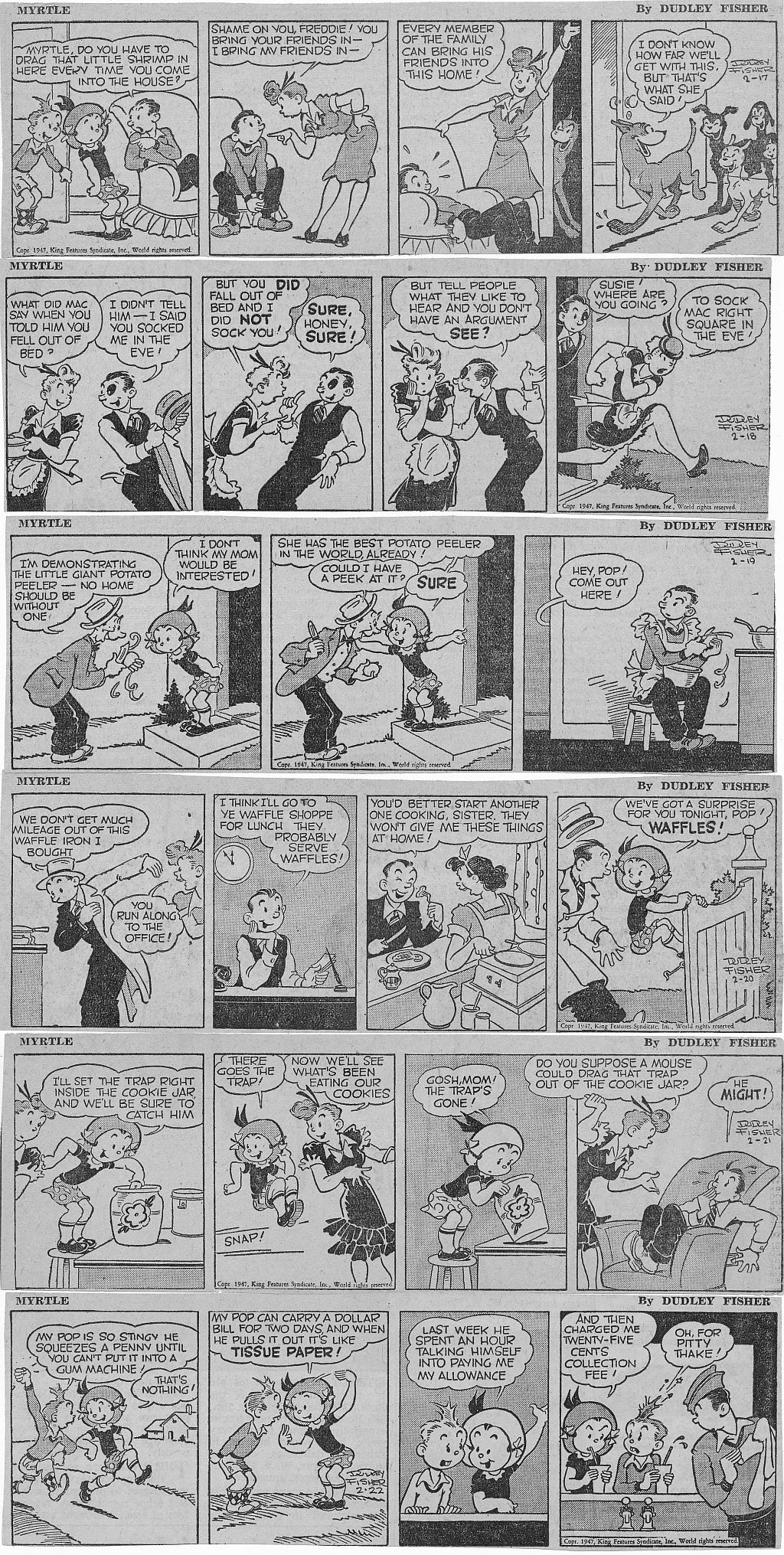 Â In Myrtle this time, from 2-17 to 2-22-1947, we’re into our first full week of strip continuity. In the 2-18, Susie reminds me of Popeye as she strides out the door ready to sock neighbor Mac in the eye! I like the little subtle touch of Pop hiding a mouse trap behind his chair in the 2-21. Fisher’s characters are so full of life, it’s fun to see Myrtle continually flying through the air, or hanging on to the garden gate, just being an energetic little girl. Many more to come. In about 5 or 6 more posts, Barker Bill will run out of episodes, so this blog will take less time to make up. For the most part, each little strip has to be separately scanned and uploaded, it takes a great deal of time, so I hope you will excuse the less-than-frequent posts. I’ll never be an Evanier, how does he do it? (Well, for one thing, he doesn’t post too many daily comic strips!)
 In Myrtle this time, from 2-17 to 2-22-1947, we’re into our first full week of strip continuity. In the 2-18, Susie reminds me of Popeye as she strides out the door ready to sock neighbor Mac in the eye! I like the little subtle touch of Pop hiding a mouse trap behind his chair in the 2-21. Fisher’s characters are so full of life, it’s fun to see Myrtle continually flying through the air, or hanging on to the garden gate, just being an energetic little girl. Many more to come. In about 5 or 6 more posts, Barker Bill will run out of episodes, so this blog will take less time to make up. For the most part, each little strip has to be separately scanned and uploaded, it takes a great deal of time, so I hope you will excuse the less-than-frequent posts. I’ll never be an Evanier, how does he do it? (Well, for one thing, he doesn’t post too many daily comic strips!)
Junior Times Chase Craig and Fred Moore!
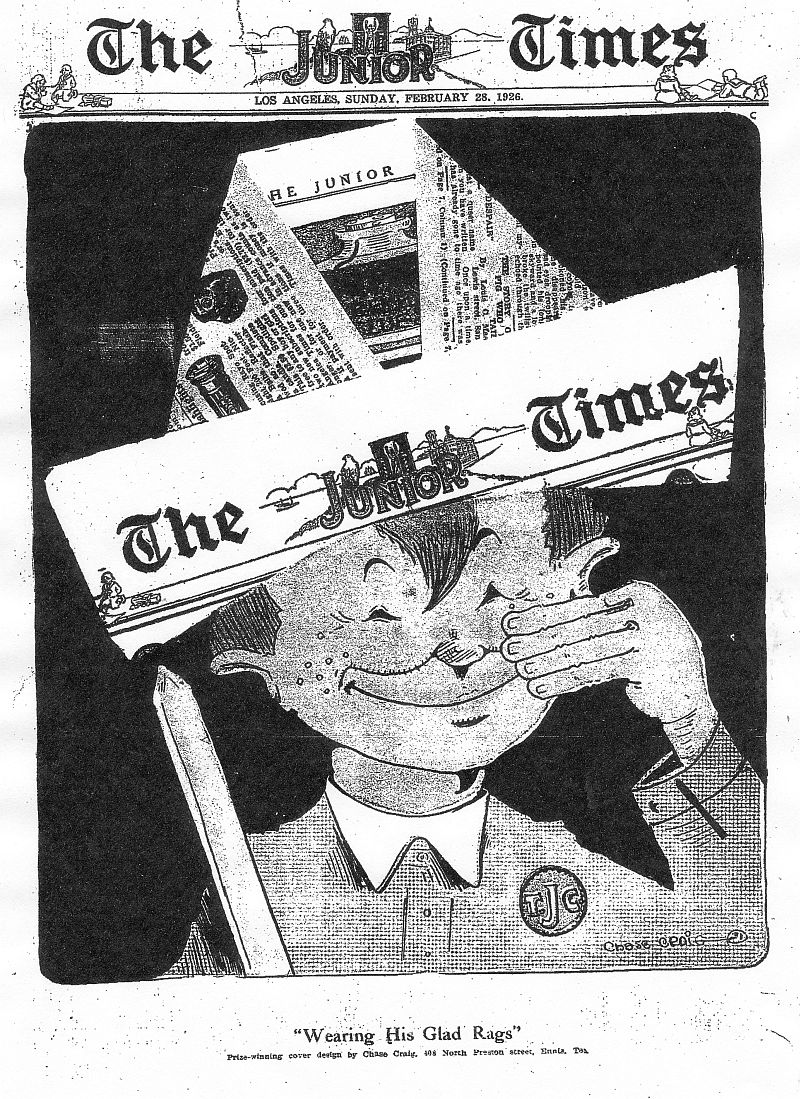






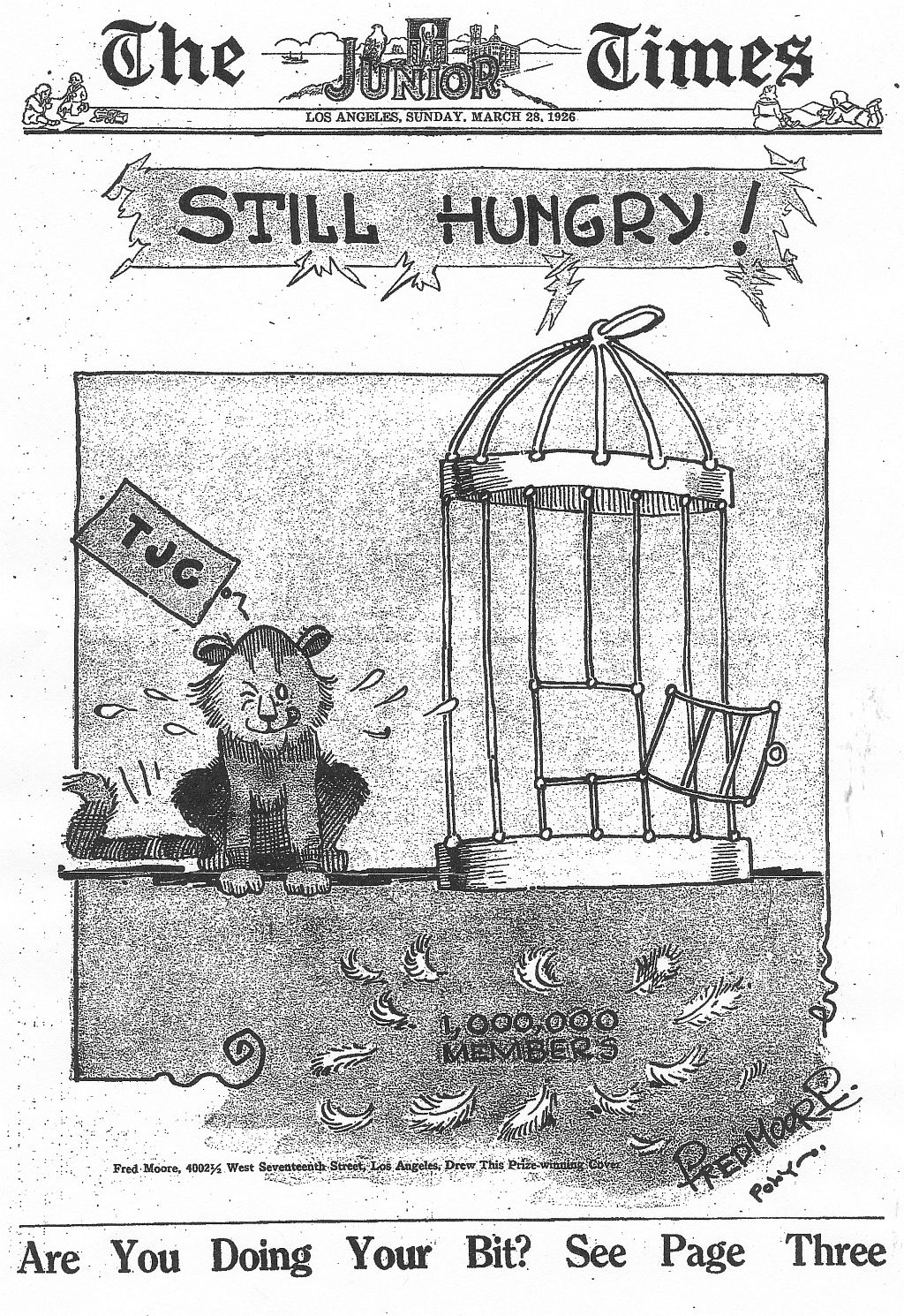  Man, these blogs are just a lot of damned hard work sometimes! This thing is running away with itself, but I just love these old strips and the early work of famous animators, so here we go again with the L.A. Junior Times from 1926! There’s a cover up there from Feb. 28th, 1926, by the pioneering comics editor and cartoonist, Chase Craig! I like the collage he brings to the design, like no other cover designer I’ve seen so far. He received the grand total of ten dollars for his design, large money for a kid in 1926. There are two “Al Falfa” strips by Chase from Feb. 14th, 1926 and an “Archy Jr.” strip by Chase’s pal, Al Perez. Al puts Chase in his “Archy Jr.” strip and makes fun of the “Al Falfa” character. I wonder if Chase knew about FARMER Al Falfa? I love these strips not so much for the jokes, which are strictly Capt. Billy material, but for all the comaraderie and high energy in the Junior Times strips. Note also that Chase had his own fanzine he published from his home in Texas called “Cartoonist and Illustrator”. I have never seen an issue of that ‘zine, have you? For a real jolt of L.A. history, check out “Bobbie’s Clown” from March 7th, 1926 by Bobby Richards. The Clown and his pal visit the Chaplin studio over on La Brea as Charlie films “The Circus”. The first panel is quite authentic, that’s the way the entrance to the studio really looked. I’ve also posted three Fred Moore cartoons, two strips, from Feb. 28th and March 21st, and another 10 dollar cover design, from March 28th, 1926. I don’t quite know what Fred was trying to imply here, did the Times Junior Club eat up it’s members? Even at this early stage of his life, Fred Moore liked cute, appealing characters, and his little cat on the Jr. Times cover is very cute. Fred drew a lot of little kid gags in his comics, these two look like they were stolen from an old Gus Edwards stage routine. Weren’t these kid cartoonists lucky back in ’26 to have Aunt Dolly of the L.A. Times? She really cared about the kids and promoted their work every way that she could. She threw lavish parties for them downtown with guests like Hoot Gibson and Tom Mix, full jazz band orchestras and all the food the kids could eat! More about the Times Junior Club cartoonists next post.
 Man, these blogs are just a lot of damned hard work sometimes! This thing is running away with itself, but I just love these old strips and the early work of famous animators, so here we go again with the L.A. Junior Times from 1926! There’s a cover up there from Feb. 28th, 1926, by the pioneering comics editor and cartoonist, Chase Craig! I like the collage he brings to the design, like no other cover designer I’ve seen so far. He received the grand total of ten dollars for his design, large money for a kid in 1926. There are two “Al Falfa” strips by Chase from Feb. 14th, 1926 and an “Archy Jr.” strip by Chase’s pal, Al Perez. Al puts Chase in his “Archy Jr.” strip and makes fun of the “Al Falfa” character. I wonder if Chase knew about FARMER Al Falfa? I love these strips not so much for the jokes, which are strictly Capt. Billy material, but for all the comaraderie and high energy in the Junior Times strips. Note also that Chase had his own fanzine he published from his home in Texas called “Cartoonist and Illustrator”. I have never seen an issue of that ‘zine, have you? For a real jolt of L.A. history, check out “Bobbie’s Clown” from March 7th, 1926 by Bobby Richards. The Clown and his pal visit the Chaplin studio over on La Brea as Charlie films “The Circus”. The first panel is quite authentic, that’s the way the entrance to the studio really looked. I’ve also posted three Fred Moore cartoons, two strips, from Feb. 28th and March 21st, and another 10 dollar cover design, from March 28th, 1926. I don’t quite know what Fred was trying to imply here, did the Times Junior Club eat up it’s members? Even at this early stage of his life, Fred Moore liked cute, appealing characters, and his little cat on the Jr. Times cover is very cute. Fred drew a lot of little kid gags in his comics, these two look like they were stolen from an old Gus Edwards stage routine. Weren’t these kid cartoonists lucky back in ’26 to have Aunt Dolly of the L.A. Times? She really cared about the kids and promoted their work every way that she could. She threw lavish parties for them downtown with guests like Hoot Gibson and Tom Mix, full jazz band orchestras and all the food the kids could eat! More about the Times Junior Club cartoonists next post.











 Here’s Barker Bill, from 4/18 to 4/30/1955. The Hippo is in big trouble as she swallows a watch with a radium dial. The midget buys a Geiger counter from Col. Whetwhistle and finds that the Hippo is radioactive! A bunch of gangsters kidnap the Hippo to mine the uranium out of her (they think). Puddy and Barker Bill trail the Hippo to the gangsters’ hide-out. The strip from 4/28 is very blurry on the copy I have here (from the Boston Globe). Here’s the dialog: Gangster: “Another juvenile delinquent, disgustin–” Moll: “Leave the poor kid alone and get goin–” Gangster: “Here goes Moll with her mudderly instincts again–” Moll: (to midget) “Diddums baddums man hittums itty bitty darling–” Midget (thinking): “Humiliatin’–But I better play along–” Puddy (to Bill):”Hey–this gives me a hot idea, Bill–Bzzz–” Puddy figures out a pretty painful way for them to escape.
Here’s Barker Bill, from 4/18 to 4/30/1955. The Hippo is in big trouble as she swallows a watch with a radium dial. The midget buys a Geiger counter from Col. Whetwhistle and finds that the Hippo is radioactive! A bunch of gangsters kidnap the Hippo to mine the uranium out of her (they think). Puddy and Barker Bill trail the Hippo to the gangsters’ hide-out. The strip from 4/28 is very blurry on the copy I have here (from the Boston Globe). Here’s the dialog: Gangster: “Another juvenile delinquent, disgustin–” Moll: “Leave the poor kid alone and get goin–” Gangster: “Here goes Moll with her mudderly instincts again–” Moll: (to midget) “Diddums baddums man hittums itty bitty darling–” Midget (thinking): “Humiliatin’–But I better play along–” Puddy (to Bill):”Hey–this gives me a hot idea, Bill–Bzzz–” Puddy figures out a pretty painful way for them to escape.






 Felix from 7-15 to 7-21-1935 has Felix and Danny still on the Ape’s island trying to re-join the Captain’s company. But the Professor’s explorers are cut off from the Captain by a giant Armadillo, who does not suffer cartoon cats gladly. Felix flies up in the air on a giant bird to signal the Captain with cigar smoke sky writing (it’s fun to see Felix smoking), and then temporarily blinds the Armadillo with pepper bombs. Will the Professor cut Felix some slack for these brave deeds? In the Sunday, Felix reforms a robber by giving him a nightmare in which all his body parts are wanted by various dentists and doctors and Indians of Dreamland. The robber is scared straight.
Felix from 7-15 to 7-21-1935 has Felix and Danny still on the Ape’s island trying to re-join the Captain’s company. But the Professor’s explorers are cut off from the Captain by a giant Armadillo, who does not suffer cartoon cats gladly. Felix flies up in the air on a giant bird to signal the Captain with cigar smoke sky writing (it’s fun to see Felix smoking), and then temporarily blinds the Armadillo with pepper bombs. Will the Professor cut Felix some slack for these brave deeds? In the Sunday, Felix reforms a robber by giving him a nightmare in which all his body parts are wanted by various dentists and doctors and Indians of Dreamland. The robber is scared straight.





  In Krazy, from 5-26 to 5-31-1941, there are two phony brick gags, two “chiggen” gags, featuring incubators and an aborted “tryst” turned into a “twist” ending by Ignatz. Herriman continues to suggest a stage setting for the Coconino Kast by popping floorboards and rugs into his foregrounds whenever he can. I especially like the 5-27, with it’s dirt path, cobblestones, floorboards and hedge that falls out of the last panel, while the big tree trunk remains stationary.
 In Krazy, from 5-26 to 5-31-1941, there are two phony brick gags, two “chiggen” gags, featuring incubators and an aborted “tryst” turned into a “twist” ending by Ignatz. Herriman continues to suggest a stage setting for the Coconino Kast by popping floorboards and rugs into his foregrounds whenever he can. I especially like the 5-27, with it’s dirt path, cobblestones, floorboards and hedge that falls out of the last panel, while the big tree trunk remains stationary.
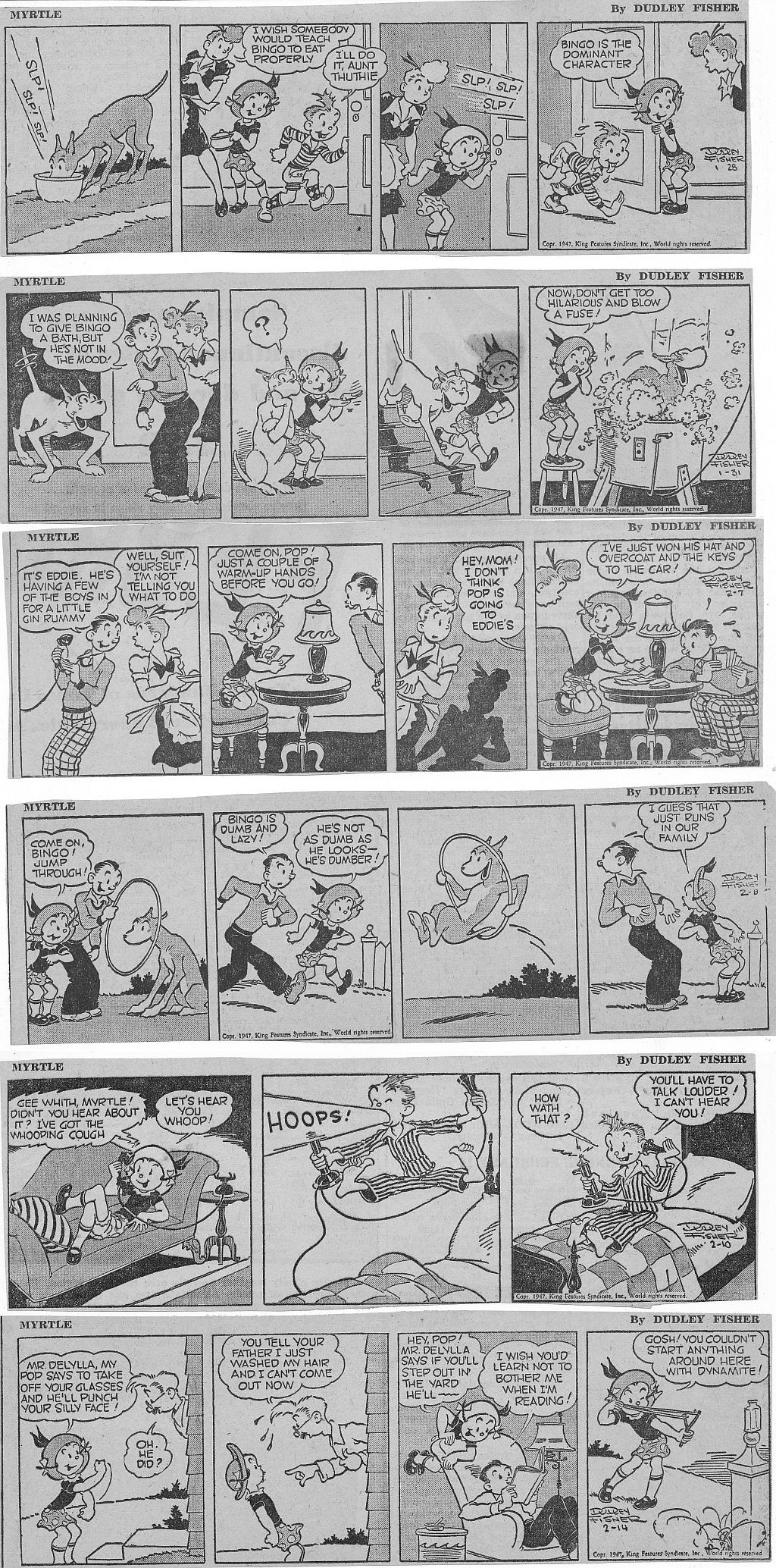  Here’s Myrtle (Right Around Home) by Dudley Fisher, from 1-18 to 2-14-1947. Next post we will get into a more regular sequence with the dates, this time we skip a lot. Bingo the merry dog is featured in the 1-18, 1-31 and 2-8, and Myrtle’s mischievous traits are revealed in the 2-7 (she plays poker better than her Dad) and the 2-14, in which she tries to start a fight between the neighbor and her Dad just for her own amusement. I love the pose that Sampson takes in the second panel of the 2-10 as he gives out with a loud “Whoop”! Fisher’s strips are full of beautiful, flexible character poses and wonderful arrangements of his character groups, with great harmony of design. Most cartoonists today have no concept of a flexible spine in a character, mostly they stand stiff as flagpoles. Composition, character groups? Mostly the same arrangements over and over again.
 Here’s Myrtle (Right Around Home) by Dudley Fisher, from 1-18 to 2-14-1947. Next post we will get into a more regular sequence with the dates, this time we skip a lot. Bingo the merry dog is featured in the 1-18, 1-31 and 2-8, and Myrtle’s mischievous traits are revealed in the 2-7 (she plays poker better than her Dad) and the 2-14, in which she tries to start a fight between the neighbor and her Dad just for her own amusement. I love the pose that Sampson takes in the second panel of the 2-10 as he gives out with a loud “Whoop”! Fisher’s strips are full of beautiful, flexible character poses and wonderful arrangements of his character groups, with great harmony of design. Most cartoonists today have no concept of a flexible spine in a character, mostly they stand stiff as flagpoles. Composition, character groups? Mostly the same arrangements over and over again.



 Â Readers, I’m gonna beat Yowp to the punch. Here’s the May, 1962, Yogi Bear Sunday pages. They are from 5-6 to 5-27. I’m sure he will have good notes on these soon over at his blog, so just keep clicking on “Yowp” over on the Blogroll, and keep tabs on him. I put one over on the old hound this time!
 Readers, I’m gonna beat Yowp to the punch. Here’s the May, 1962, Yogi Bear Sunday pages. They are from 5-6 to 5-27. I’m sure he will have good notes on these soon over at his blog, so just keep clicking on “Yowp” over on the Blogroll, and keep tabs on him. I put one over on the old hound this time!
People, I’m exhausted, but you can catch more craziness on the Cat’s new Facebook page: www.facebook.com/someothercat . There, you will see drawings and a few cel set-ups from the short currently before the cameras, “There Must Be Some Other Cat”. Itza (the Cat’s name) would love to be “Friends” with you over there. Humph, I’ve been doing this blog for five years, where are all my “Friends”!?
Until the next time, Bullet your Heart and Hall Lugea!
Right Around Home!
Do you recognize this wonderful layout style? It’s the 3/4 downshot, one of the most difficult angles to stage action from, done to perfection every week in a Sunday page called “Right Around Home with Myrtle”. This episode was probably drawn by Bob Vittur, but the feature was originated by a cartoonist named Dudley Fisher. Starting this post, the Cat and I will start reprinting some of the daily episodes of the strip, starting Jan. 13, 1947:
I love the character of Little Myrtle, and you’ll get to know her better through these dailies, scanned from newspaper clippings. I’m starting out just posting a few at a time, as the first few weeks of the strip in this collection skip quite a few dates. There IS a little bit of continuity, but it’s mainly the adventures of Myrtle, Freddie and Susie (her parents), Sampson (her lisping boy friend), Slug (her brother), Alice and Archie (the birds in the 1-25 above) and the funny canine characters Bingo and Junior. The Sunday pages mostly “star” the 3/4 staging in one large panel, but the dailies are more intimate, and Myrtle’s tomboy, energetic personality comes to the fore. I like the way Fisher uses Myrtle’s hat as a “bubble” around her face, you can’t tell it’s much of a hat until she turns profile, but that’s part of the abstraction in Fisher’s cartooning. Like Patrick from 1967, Myrtle is a disruptive force in her parents’ and neighborhood’s lives. UNlike Patrick, she is never mean or mean-spirited, just a lot of fun. The characters in “Right Around Home” know they are in a comic strip, and comment occasionally to the reader about that. A lot of people seem to enjoy this comic, hope you will too. The cat character in the strip is named “Hyacinth”, by the way.
Recent finds in the L.A. Jr. Times!
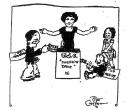 Â Bob Clampett draws Aunt Dolly, 12-6-25
 Bob Clampett draws Aunt Dolly, 12-6-25
 Â
  The first two Fred Moore comics from the Junior Times, 1-17 and 2-7-1926. The last panel in the 1-27 is illegible.
The first two Fred Moore comics from the Junior Times, 1-17 and 2-7-1926. The last panel in the 1-27 is illegible.
 Â
 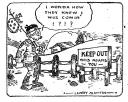 The earliest Larry Martin comics, from 11-15-25, he called himself “Buster” in the first one.
The earliest Larry Martin comics, from 11-15-25, he called himself “Buster” in the first one.
 Â Cartoonist Alex Perez makes Chase Craig into one of his characters, 2-7-26.
 Cartoonist Alex Perez makes Chase Craig into one of his characters, 2-7-26.
 Â George Manuell 12-13-25,
 George Manuell 12-13-25, 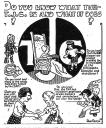  Ray Patin 12-20-25,
 Ray Patin 12-20-25,  Frank Tipper (?) 11-8-25
 Frank Tipper (?) 11-8-25  Manuel Moreno doing a parody of the 1925 hit: “Doodle Doo Doo” as a salute to the Times Junior Club, 12-27-25. It just gets better as it goes along folks! Too many interesting comics to post!
 Manuel Moreno doing a parody of the 1925 hit: “Doodle Doo Doo” as a salute to the Times Junior Club, 12-27-25. It just gets better as it goes along folks! Too many interesting comics to post!













 Â In Barker Bill this time, from 4-4 to 4-17-1955, the Cold War moves in on the story. Russian Spies Dripsky and Bugovitch want to cop Col. Whetwhistle’s Boo-Boo Tonic to disguise themselves as plants to be placed in Washington D.C. hotel lobbies. That way, they can overhear state secrets! Barker Bill and Puddy are on the job, though, and foil the spie’s plot. Puddy is made an honorary member of the K-9 Corps for his service. The supply of Barker Bill Sundays just about dries up this time, in the 4-10, Puddy is scratched up by a lot of alley cats, and in the 4-17, Puddy tries to eat a dinosaur skeleton.
 In Barker Bill this time, from 4-4 to 4-17-1955, the Cold War moves in on the story. Russian Spies Dripsky and Bugovitch want to cop Col. Whetwhistle’s Boo-Boo Tonic to disguise themselves as plants to be placed in Washington D.C. hotel lobbies. That way, they can overhear state secrets! Barker Bill and Puddy are on the job, though, and foil the spie’s plot. Puddy is made an honorary member of the K-9 Corps for his service. The supply of Barker Bill Sundays just about dries up this time, in the 4-10, Puddy is scratched up by a lot of alley cats, and in the 4-17, Puddy tries to eat a dinosaur skeleton.






 Â In Felix, from 7-8 to 7-14-1935, the serpent vine story continues as Danny escapes and saves Felix. Felix is given credit for the discovery of the vine by the Professor, but in the 7-11, Felix could care less about his discovery, he just cares about his recovery. A sailor who is an expert wrestler tackles the vine next. In the Sunday, Felix again plays God from Dreamland heaven as he changes the life of Tommy, the little lier by giving him a fantastic nightmare. I like the panel where the God-Devil Felix lies in wait for Tommy with a Candy Box containing a vicious leopard!
 In Felix, from 7-8 to 7-14-1935, the serpent vine story continues as Danny escapes and saves Felix. Felix is given credit for the discovery of the vine by the Professor, but in the 7-11, Felix could care less about his discovery, he just cares about his recovery. A sailor who is an expert wrestler tackles the vine next. In the Sunday, Felix again plays God from Dreamland heaven as he changes the life of Tommy, the little lier by giving him a fantastic nightmare. I like the panel where the God-Devil Felix lies in wait for Tommy with a Candy Box containing a vicious leopard!





 Â Krazy from 5-19 to 5-24-1941, features the brick, both rubber and clay types. I love the gag in the 5-24 where Mrs. Kwakk-Wakk asks Krazy if he ever gets headaches from all the brick punishment that his cranium takes. Krazy responds by using a barrel to protect his body! What a mahogany head!
 Krazy from 5-19 to 5-24-1941, features the brick, both rubber and clay types. I love the gag in the 5-24 where Mrs. Kwakk-Wakk asks Krazy if he ever gets headaches from all the brick punishment that his cranium takes. Krazy responds by using a barrel to protect his body! What a mahogany head!
Speaking of cats, my cartoon cat, who now has named himself “Itza”, rebelled against me and escaped to Facebook. I don’t feel comfortable on Facebook, I don’t like to be that easily available on the ‘net, it scares me! But Itza is fearless where the Internet is concerned. He’ll still visit here from time to time, but if you want to see him all the time and maybe write to him, go to www.facebook.com/someothercat and you’ll see what the great webmeister Charles Brubaker and Itza cooked up! There are some drawings and cel set-ups from TMBSOC there as well. I really didn’t want to post any links to Facebook, but Itza threatened me with a loaded cactus.
The First Bob Clampett Cartoooons! 1925-L.A. Jr. Times
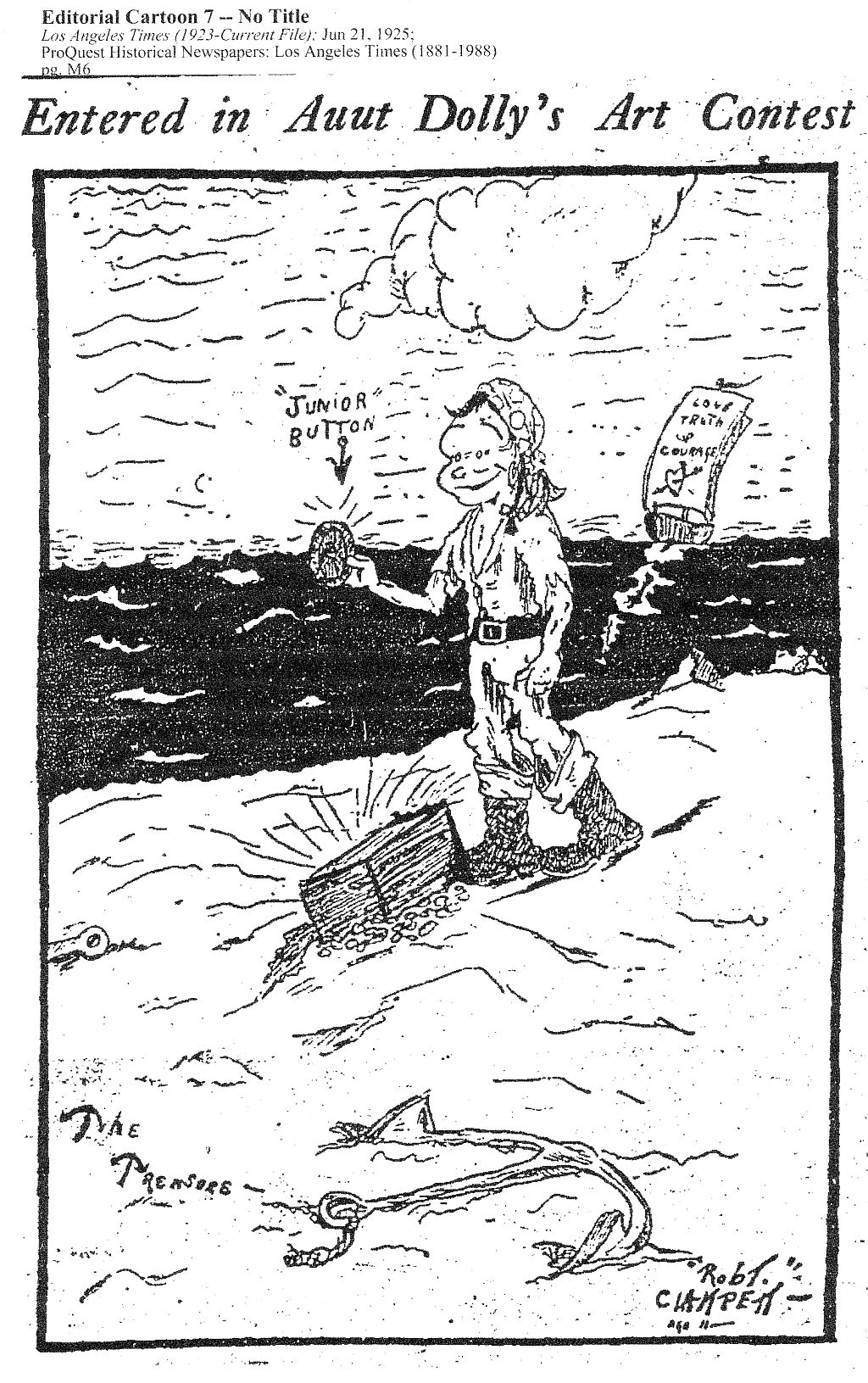 Â In reading the L.A. Junior Times through Proquest, I keep coming across the childhood drawings of famous cartoonists. Now I’ve found the earliest Bob Clampett drawing published in the Junior Times, June 21st, 1925. It appears to be a self-caricature of the young cartoonist as a pirate, finding a Junior Times Club button on a desert island. The drawing is labelled: “The Treasure” and was drawn by Bob at the tender age of eleven! By 1925, the Times Junior Club, or “T.J.C.”, was a thriving org., loved the world over, or at least as far as Chicago, where the The Chicago Tribune, which contributed many features and comic strips to the L.A. Times, Â held sway. They gave cash prizes for original stories, poetry, art and comic strips to the children who sent them in to the Times. They helped poor children, gave big dances at the Times building for all the kids, threw elaborate Christmas parties, and made it a lot of fun just to be a kid. A lady named “Aunt Dolly” was the lynchpin of the T.J.C., and seems to have been well-loved and respected by the aspiring cartoonists and authors in the Junior Times audience.
 In reading the L.A. Junior Times through Proquest, I keep coming across the childhood drawings of famous cartoonists. Now I’ve found the earliest Bob Clampett drawing published in the Junior Times, June 21st, 1925. It appears to be a self-caricature of the young cartoonist as a pirate, finding a Junior Times Club button on a desert island. The drawing is labelled: “The Treasure” and was drawn by Bob at the tender age of eleven! By 1925, the Times Junior Club, or “T.J.C.”, was a thriving org., loved the world over, or at least as far as Chicago, where the The Chicago Tribune, which contributed many features and comic strips to the L.A. Times,  held sway. They gave cash prizes for original stories, poetry, art and comic strips to the children who sent them in to the Times. They helped poor children, gave big dances at the Times building for all the kids, threw elaborate Christmas parties, and made it a lot of fun just to be a kid. A lady named “Aunt Dolly” was the lynchpin of the T.J.C., and seems to have been well-loved and respected by the aspiring cartoonists and authors in the Junior Times audience.
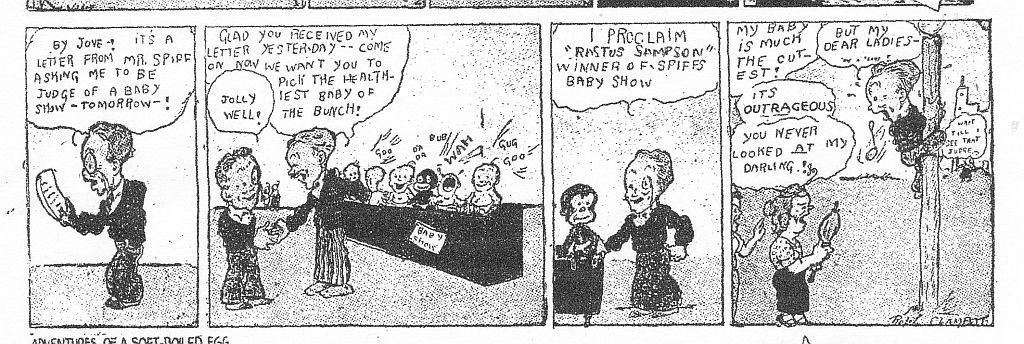 Â This little strip, from June 12th, 1925, is the earliest actual comic that Bob Clampett drew. It’s especially interesting, because at age eleven, Bob already thought that little babies and black characters were funny. The style of art seems patterned after Hardie Gramatky’s, but unlike most of the comics that the Junior Times published, Bob is trying to do a gag with his strip. It’s interesting how the little black baby, “Rastus Sampson”, resembles Bosko, long before Bosko was in production. The timing between the third and fourth panels is also quite sophisticated for an eleven year old kid. The reader can imagine the outrage of the dowagers in the baby contest audience as they chase the British dandy up the telegraph pole. There is some fine print in the Dandy’s dialog balloon that I can’t make out, after “But my dear ladies–“. This strip anticipates the “Black Beauty” gag in “A Coy Decoy”, and of course, “Baby Bottleneck”.
 This little strip, from June 12th, 1925, is the earliest actual comic that Bob Clampett drew. It’s especially interesting, because at age eleven, Bob already thought that little babies and black characters were funny. The style of art seems patterned after Hardie Gramatky’s, but unlike most of the comics that the Junior Times published, Bob is trying to do a gag with his strip. It’s interesting how the little black baby, “Rastus Sampson”, resembles Bosko, long before Bosko was in production. The timing between the third and fourth panels is also quite sophisticated for an eleven year old kid. The reader can imagine the outrage of the dowagers in the baby contest audience as they chase the British dandy up the telegraph pole. There is some fine print in the Dandy’s dialog balloon that I can’t make out, after “But my dear ladies–“. This strip anticipates the “Black Beauty” gag in “A Coy Decoy”, and of course, “Baby Bottleneck”.
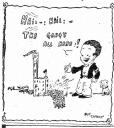

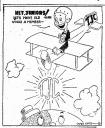 Â These three little panels were published, July 19th, Sept. 25th and June 28th, 1925. The first two are by Bob Clampett, and the third is by Chase Craig, later editor at Western Printing and Lithographing, and Carl Barks’s boss for a while. In the first one, Bob seems to be presenting a typical 1920s Harold Teen type, celebrating with the “gang” near the L.A. Times building downtown, in the second one, Bob is promoting the Junior Times “Comics by Club Cartoonists” page, and Chase Craig is doing the sort of one-world boosterism so typical of the L.A. Times all through the years. The talent latent in these kid cartoonists of the 1920s, continues to impress me. I hope to find more.
 These three little panels were published, July 19th, Sept. 25th and June 28th, 1925. The first two are by Bob Clampett, and the third is by Chase Craig, later editor at Western Printing and Lithographing, and Carl Barks’s boss for a while. In the first one, Bob seems to be presenting a typical 1920s Harold Teen type, celebrating with the “gang” near the L.A. Times building downtown, in the second one, Bob is promoting the Junior Times “Comics by Club Cartoonists” page, and Chase Craig is doing the sort of one-world boosterism so typical of the L.A. Times all through the years. The talent latent in these kid cartoonists of the 1920s, continues to impress me. I hope to find more.











 Â The crazy continuities continue in the Barker Bill strip from 3-21 to 4-2-1955. Puddy the Pup finds the missing Pom-Pom the performing Poodle, and she’s had a litter of pups! Puddy’s laryngitis keeps the suspense going for a while, will he speak in public or not? A new story starts April first, as a medicine showman appears selling “Whetwhistle’s Wonderful Elixir” made from the sap of the Boo-Boo tree. If the customer drinks the elixir, it makes him or her want to chew wood! I’m expecting Woody Woodpecker to get involved in this story somehow!
 The crazy continuities continue in the Barker Bill strip from 3-21 to 4-2-1955. Puddy the Pup finds the missing Pom-Pom the performing Poodle, and she’s had a litter of pups! Puddy’s laryngitis keeps the suspense going for a while, will he speak in public or not? A new story starts April first, as a medicine showman appears selling “Whetwhistle’s Wonderful Elixir” made from the sap of the Boo-Boo tree. If the customer drinks the elixir, it makes him or her want to chew wood! I’m expecting Woody Woodpecker to get involved in this story somehow!






 Â In Felix from 7-1 to 7-7-1935, Felix finds the missing Danny Dooit by trailing the turtle that inadvertently kidnapped the boy. Felix rescues Danny from a rushing river, but both the Cat and the Kid are trapped by the horrible serpent vine in the 7-6. The Sunday page is full of kid antics as Bobby Dazzler trades blows with a bully, and Felix saves a boy from becoming obsessed with firearms, by giving him a bad dream. Winsor McCay continues as ghost-writer for Messmer, (strictly a fabrication).
 In Felix from 7-1 to 7-7-1935, Felix finds the missing Danny Dooit by trailing the turtle that inadvertently kidnapped the boy. Felix rescues Danny from a rushing river, but both the Cat and the Kid are trapped by the horrible serpent vine in the 7-6. The Sunday page is full of kid antics as Bobby Dazzler trades blows with a bully, and Felix saves a boy from becoming obsessed with firearms, by giving him a bad dream. Winsor McCay continues as ghost-writer for Messmer, (strictly a fabrication).





 Â Glass-blowers, “chiggin”s, bread upon the waters and shoeless dogs inhabit the Coconino stage this time, from 5-12 to 5-17-1941. Speaking of stages, the lower third of the Krazy daily in 1941Â is usually taken up by Herriman’s drawings of floorboards, footlights, prompter’s boxes and little staircases, implying that the desert cast is really doing their little gags for the reader on an ever-changing theater stage. As 1940s newspapers continued to crowd daily strips on to a single page, the lower third of the strip was often cut-out to make room. Garge was being creative with that lower third, and using it as a stage was an expendable way to get around comic strip butchery, without sacrificing the gag.
 Glass-blowers, “chiggin”s, bread upon the waters and shoeless dogs inhabit the Coconino stage this time, from 5-12 to 5-17-1941. Speaking of stages, the lower third of the Krazy daily in 1941 is usually taken up by Herriman’s drawings of floorboards, footlights, prompter’s boxes and little staircases, implying that the desert cast is really doing their little gags for the reader on an ever-changing theater stage. As 1940s newspapers continued to crowd daily strips on to a single page, the lower third of the strip was often cut-out to make room. Garge was being creative with that lower third, and using it as a stage was an expendable way to get around comic strip butchery, without sacrificing the gag.
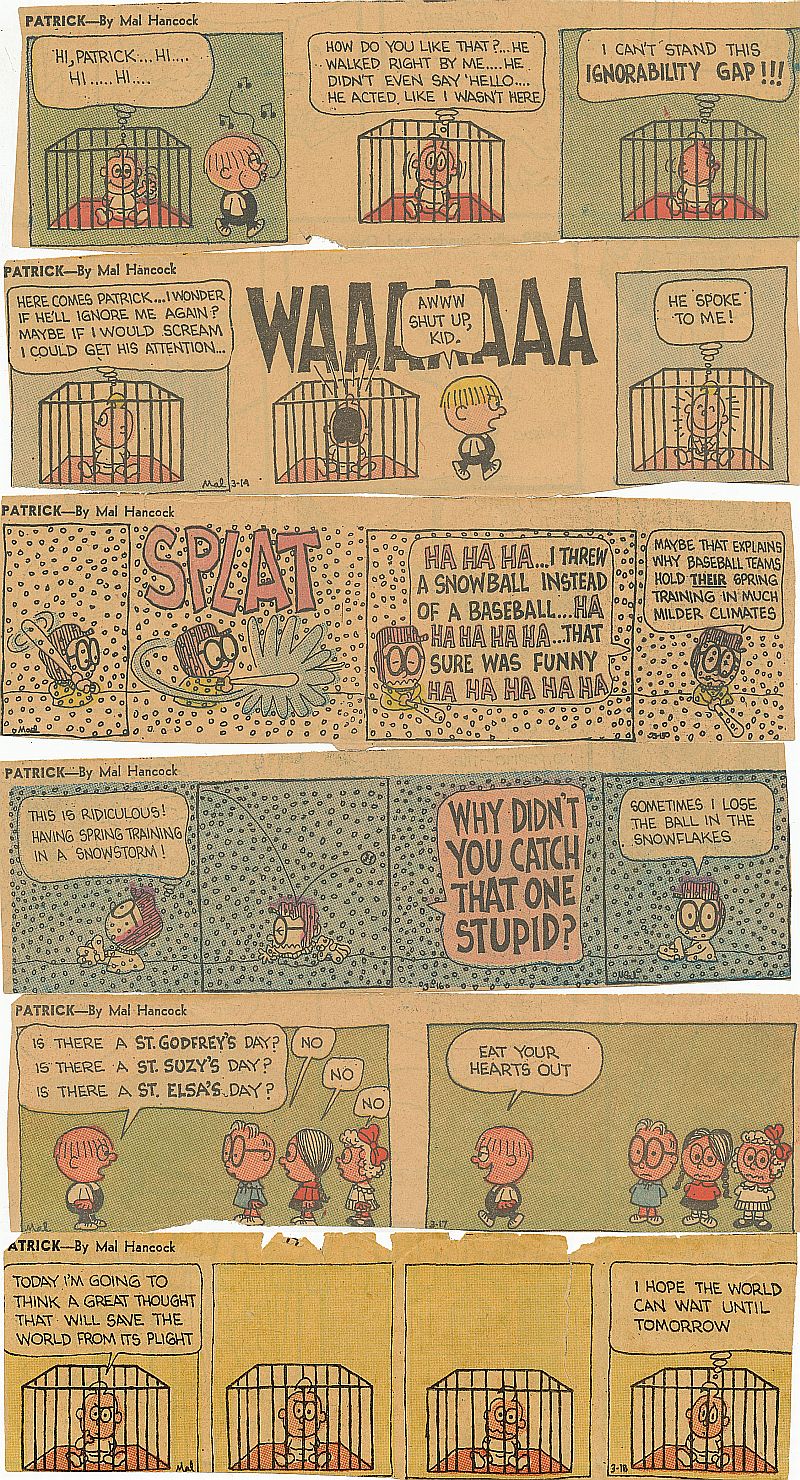 Â Patrick is from 3-13 to 3-18-1967 this time, and we continue to see the rise of Nathan to the starring position. He has three strips mostly to himself. Godfrey also tries to play baseball in a snowstorm, and Patrick thinks that St. Patrick’s day is named for him in the 3-17. Nathan proves ironically prophetic in the 3-18, as he thinks: “I hope the world can wait until tomorrow.” The St. Louis Post-Dispatch did not wait, but dropped “Patrick” after this strip was published. Next time I’ll be presenting another favorite kid strip, many years older than Patrick, by a fine cartoonist.
 Patrick is from 3-13 to 3-18-1967 this time, and we continue to see the rise of Nathan to the starring position. He has three strips mostly to himself. Godfrey also tries to play baseball in a snowstorm, and Patrick thinks that St. Patrick’s day is named for him in the 3-17. Nathan proves ironically prophetic in the 3-18, as he thinks: “I hope the world can wait until tomorrow.” The St. Louis Post-Dispatch did not wait, but dropped “Patrick” after this strip was published. Next time I’ll be presenting another favorite kid strip, many years older than Patrick, by a fine cartoonist.
Yowp has put up black and white, edited versions of these four Yogi Bear Sunday Pages from 4-1, 8, 15 and 22-1962 on his blog. I, as usual, take the bait and post these four clippings from my collection to augment Yowp’s post. I am missing the strip from 4-29, you’ll have to visit Yowp’s blog to see it, just click the link over to the right side of the page. By the way, don’t forget to click the small images to enlarge them.
A big tip of the Cat’s whiskers to Margo Burns of New Hampshire, who purchased a cel from Sc. 22 of “It’s ‘The Cat'”. You should have your cel and complimentary DVD of the cartoon by now, Margo. These cels are still a grand bargain, my readers, for the list price, you get free shipping, a free copy of the DVD, and the cel and (usually) the pencil drawing from which it was traced! It’s almost as good a deal as a membership in the Times Junior Club! Just go to https://itsthecat.com/Gallery-FilmArt.htm and find a cel that you like. Our new production can use the donation, and you will get a beautiful cel from the first cartoon that Greg Ford and I produced. If you want to contribute to our Paypal account, like our friend Bill Warren so generously did, just go to kausler@att.net over on Paypal, and contribute anything you can spare. If you contribute at least $200.00, you will receive screen credit on TMBSOC. Thanks, and keep reading!!
Special 5th Anniversary Post!!
Today, March 27th, 2012, I’m celebrating five years of writing and editing a “blog”. As a special contribution, GREG FORD, my producer on the short cartoon: “There Must Be Some Other Cat”, has sent the first 100 feet of color shots! When I started the CATBLOG, I had no idea which direction it would take, and I knew next to nothing about computers. If truth be told, I had a very strong aversion to the Demon Machines. I didn’t even know how to resize photos and art work so that they could be “published”. I still don’t know how to do a lot of stuff, never got microsoft word or photoshop, but I have word perfect and irfanview, both are free programs and do what I require.
I started out kinda high falutin’, publishing photos of places that Cathy and I have visited for painting trips. Soon, cartoons and comic strips crept into the mix, and now it’s about 90% comic strips. I can’t really make a good defense of reprinting old comic strips, it’s just that I love so many of them, and I’m trying to help them to be remembered. I tried to do a feature for a while where I read DOROTHY PARKER and some of my favorite children’s lit. aloud, but I’m not a great reader, and I got very little response. Again, too high-falutin’.
The CATBLOG was really supposed to be a production journal of the motion picture cartoon: “There Must Be Some Other Cat”, or TMBSOC for short. However, due to fate, TMBSOC and “The Cat” and especially my good friend and producer Greg Ford, have gone through 5 years of hard times and privation. Greg and “The Cat” have lived through a horrible economic crash, the death of cel animation (due in part to these here demon computers), a devastating apartment fire that Greg and his girlfriend Ronnie Schieb managed to survive, the bankruptcy of Kodak and the looming end of all types of photographic film (again, thanks to the demon machines) and now, health problems have affected Ronnie’s life and consequently, Greg’s life (not due to the demon machines). Through all this and more, TMBSOC proceeded at a Snail-Cat’s pace for the last 5 years in the Manhattan jungles. As you can see by the above frame grabs, “The Cat” is beginning to emerge. The scenes really look beautiful projected on 35mm FILM, and I’m so grateful that Greg and many stalwart artists still cared enough to put their best efforts into what seemed like a doomed enterprise.
This Blog has chronicled the passing of many loved ones, friends (Vincent Davis, John Bohnenberger), family (my mother), and animals (Crispy, Little Grey). It has made new friends for me, and regretfully lost some. One of the most popular posts was the article about my visit to Ollie Johnston’s house after he had moved in with his family in Oregon.
(“Here’s the Pitch” Department) Dear Readers, if you can, please buy a cel from “It’s ‘The Cat'” over at https://itsthecat.com/Gallery-FilmArt.htm. If you don’t like the prices, make an offer! We’ll be glad to listen. Also, if you care to contribute any production money directly to “There Must Be Some Other Cat”, you may PayPal it to us at: kausler@att.net or just write to me at: Mark Kausler, 1632 Loma Crest, Glendale, Ca. 91205-3710. Any contribution over $200.00 will get you a screen credit as an “Ailurophile” (Cat lover). Now is the time! The cameras are actually rolling and we need your help. Thanks so much!











 Â In Barker Bill this time, from 3-7 to 3-19-1955, there is a daily missing, 3-8, and a Sunday out, 3-20. It’s easy to follow the conclusion of the Gelt’s story without the 3-8, the Gelt turns out to be a “hen” and lays an egg. In the story starting on 3-16, Puddy falls in love with the new Circus star, Pompom the poodle. In order to impress her, Puddy decides to speak in public for the first time, and perform “Paul Revere”.
 In Barker Bill this time, from 3-7 to 3-19-1955, there is a daily missing, 3-8, and a Sunday out, 3-20. It’s easy to follow the conclusion of the Gelt’s story without the 3-8, the Gelt turns out to be a “hen” and lays an egg. In the story starting on 3-16, Puddy falls in love with the new Circus star, Pompom the poodle. In order to impress her, Puddy decides to speak in public for the first time, and perform “Paul Revere”.



 Â
 

 In Felix, from 6-24 to 6-30-1935, Felix and the Professor’s party search for the missing Danny Dooit, and Felix accidentally discovers a rare cannibal plant. In the Sunday, Messmer continues the attractive 9 panel layout from last week. I love the giant Dream Control machine in the second panel, and the silhouette of the little boy against flame in panel five.
In Felix, from 6-24 to 6-30-1935, Felix and the Professor’s party search for the missing Danny Dooit, and Felix accidentally discovers a rare cannibal plant. In the Sunday, Messmer continues the attractive 9 panel layout from last week. I love the giant Dream Control machine in the second panel, and the silhouette of the little boy against flame in panel five.





  In Krazy this time, from 5-5 to 5-10-1941, gag-a-day continues. I love the crocodile design in the 5-5, Krazy knows that the croc is crying because he’s ugly, and diplomatically says so in the last panel.
 In Krazy this time, from 5-5 to 5-10-1941, gag-a-day continues. I love the crocodile design in the 5-5, Krazy knows that the croc is crying because he’s ugly, and diplomatically says so in the last panel.
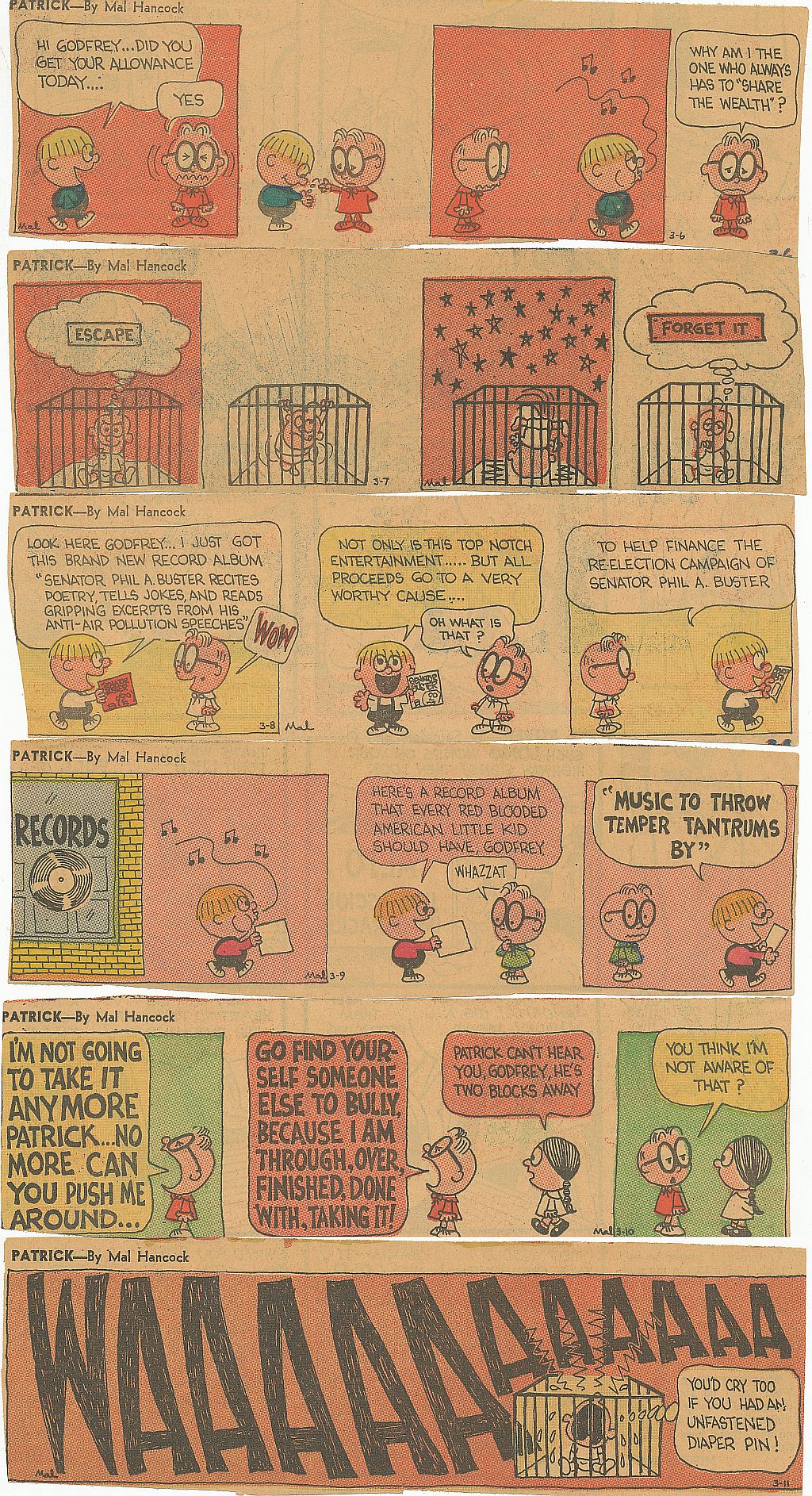 Â In Patrick, from 3-6 to 3-11-1967, Nathan stars in two strips, and Patrick and Godfrey dominate the action the rest of the week. In the 3-8, Patrick works in a little political satire, commenting on the campaign fund-raising efforts of Senator Phil A. Buster. I’ll bet that Patrick would have taken great delight in today’s Super PACs! Remember to click on all the above images to enlarge the strips. By the way, who knows how long the archives to this blog will exist, so if you like the strips, download and save them for yourself! We have the complete Felix strips from 1936 in here, the almost complete “Marvelous Mike” strip, and quite a chunk of “Patrick”, amongst other rareties. Do yourself a favor, save them or lose them!
 In Patrick, from 3-6 to 3-11-1967, Nathan stars in two strips, and Patrick and Godfrey dominate the action the rest of the week. In the 3-8, Patrick works in a little political satire, commenting on the campaign fund-raising efforts of Senator Phil A. Buster. I’ll bet that Patrick would have taken great delight in today’s Super PACs! Remember to click on all the above images to enlarge the strips. By the way, who knows how long the archives to this blog will exist, so if you like the strips, download and save them for yourself! We have the complete Felix strips from 1936 in here, the almost complete “Marvelous Mike” strip, and quite a chunk of “Patrick”, amongst other rareties. Do yourself a favor, save them or lose them!
I had such a long rant today, that it crowded out the L.A. Jr. Times comics, to be continued in the next post.Â
Gramatky and Moreno, L.A. Times Junior Cartoonists!





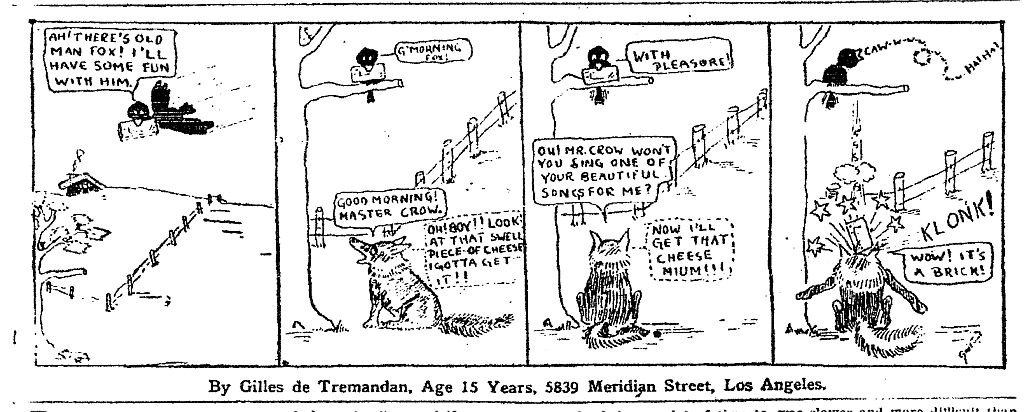 Â We lead off again this time with more strips from the 1924 L.A. Junior Times. Hardie Gramatky and Manuel Moreno produced more work than any of the other kids and managed to get something in almost every issue of the Junior Times. They were paid the whopping sum of $2.50 for every drawing published. Hardie started a feature called “Captain Kidd” in the 9/7/24 issue. From the outset, Hardie has a lot of maturity in his cartoon style, the way he arranges panels reminds me of Roy Crane’s “Wash Tubbs”. Hardie also drew the cover of the 7-13-24 issue, which starts our post this time. Manuel Moreno continued with two comic strip series, The Boy with the Answers, and “The Tuttlems”, which seems to be his version of “The Bungle Family”. I love the characters ‘plopping’ out of the panels on the punch lines. The dates of Moreno’s strips are, respectively, 7/20, 7/27, 8/3, 8/10 and 8/17/1924. As a coda, I’ve included an early strip by Gilles de Tremandan, an Aesop Fable gag featuring the Fox and Crow, published 8/31/1924. Gilles was 15 when he drew this, by the early 1930s he was animating at Disney under the name “Frenchy” (on the drafts, anyway). The old timers always said that they “drew better” than the young whippersnappers, but if you study the childhood drawings of the first wave of old master animators, their drawings look mostly untrained and immature. They learned a great deal in a short time, thanks to the intensive atmosphere of the Disney studio.
 We lead off again this time with more strips from the 1924 L.A. Junior Times. Hardie Gramatky and Manuel Moreno produced more work than any of the other kids and managed to get something in almost every issue of the Junior Times. They were paid the whopping sum of $2.50 for every drawing published. Hardie started a feature called “Captain Kidd” in the 9/7/24 issue. From the outset, Hardie has a lot of maturity in his cartoon style, the way he arranges panels reminds me of Roy Crane’s “Wash Tubbs”. Hardie also drew the cover of the 7-13-24 issue, which starts our post this time. Manuel Moreno continued with two comic strip series, The Boy with the Answers, and “The Tuttlems”, which seems to be his version of “The Bungle Family”. I love the characters ‘plopping’ out of the panels on the punch lines. The dates of Moreno’s strips are, respectively, 7/20, 7/27, 8/3, 8/10 and 8/17/1924. As a coda, I’ve included an early strip by Gilles de Tremandan, an Aesop Fable gag featuring the Fox and Crow, published 8/31/1924. Gilles was 15 when he drew this, by the early 1930s he was animating at Disney under the name “Frenchy” (on the drafts, anyway). The old timers always said that they “drew better” than the young whippersnappers, but if you study the childhood drawings of the first wave of old master animators, their drawings look mostly untrained and immature. They learned a great deal in a short time, thanks to the intensive atmosphere of the Disney studio.













 Barker Bill is from 2-21 to 3-6-1955 this time. Dog Biscuit the horse gets a new pair of glasses and gets circus ambitions almost right away. They discourage the stage struck horse by encouraging the fat lady to ride Dog Biscuit bareback! The Gelt re-enters the story line as a Treasury Man shows up to question Bill about the expense of feeding the money-eating critter. In the Sundays, Gertie the Hippo in the 2-27, resembles the proud lineage of Terrytoons hippopotami, especially in her egg-hatching pose in the last panel. Little May is in the 3-6, as the Circus Problem Child once more. The strips here come from Winnipeg and Boston, hope you enjoy them.
Barker Bill is from 2-21 to 3-6-1955 this time. Dog Biscuit the horse gets a new pair of glasses and gets circus ambitions almost right away. They discourage the stage struck horse by encouraging the fat lady to ride Dog Biscuit bareback! The Gelt re-enters the story line as a Treasury Man shows up to question Bill about the expense of feeding the money-eating critter. In the Sundays, Gertie the Hippo in the 2-27, resembles the proud lineage of Terrytoons hippopotami, especially in her egg-hatching pose in the last panel. Little May is in the 3-6, as the Circus Problem Child once more. The strips here come from Winnipeg and Boston, hope you enjoy them.






 Â Felix is from 6-17 to 6-23-1935, and continues the mad adventures of Danny Dooit and the crew on the Ape’s Island. The giant Duck from last week is here again, still with the walky-talky in his tummy. The island parrots pick up his repeated “Hellos” and broadcast them all over the place, frustrating the old explorer. About this time, Laura is replaced as the top feature on the Sunday page by “Bobby Dazzler”, a ‘Skippy’ like small boy, designed by Otto Messmer. The parrot gag in the dailies almost seems like a farewell to Laura parrot jokes, but it’s probably just a coincidence.
 Felix is from 6-17 to 6-23-1935, and continues the mad adventures of Danny Dooit and the crew on the Ape’s Island. The giant Duck from last week is here again, still with the walky-talky in his tummy. The island parrots pick up his repeated “Hellos” and broadcast them all over the place, frustrating the old explorer. About this time, Laura is replaced as the top feature on the Sunday page by “Bobby Dazzler”, a ‘Skippy’ like small boy, designed by Otto Messmer. The parrot gag in the dailies almost seems like a farewell to Laura parrot jokes, but it’s probably just a coincidence.





 Â Krazy, from 4-28 to 5-3-1941, is quite shocking! All the gags deal with cats’ fur being a good conductor of electricity, until Offissa Pupp figures out how to electrify Ignatz’s brick to discourage him from throwing it. I love Pupp’s understatement in the 5-2, “I expect him to drop it.”
 Krazy, from 4-28 to 5-3-1941, is quite shocking! All the gags deal with cats’ fur being a good conductor of electricity, until Offissa Pupp figures out how to electrify Ignatz’s brick to discourage him from throwing it. I love Pupp’s understatement in the 5-2, “I expect him to drop it.”
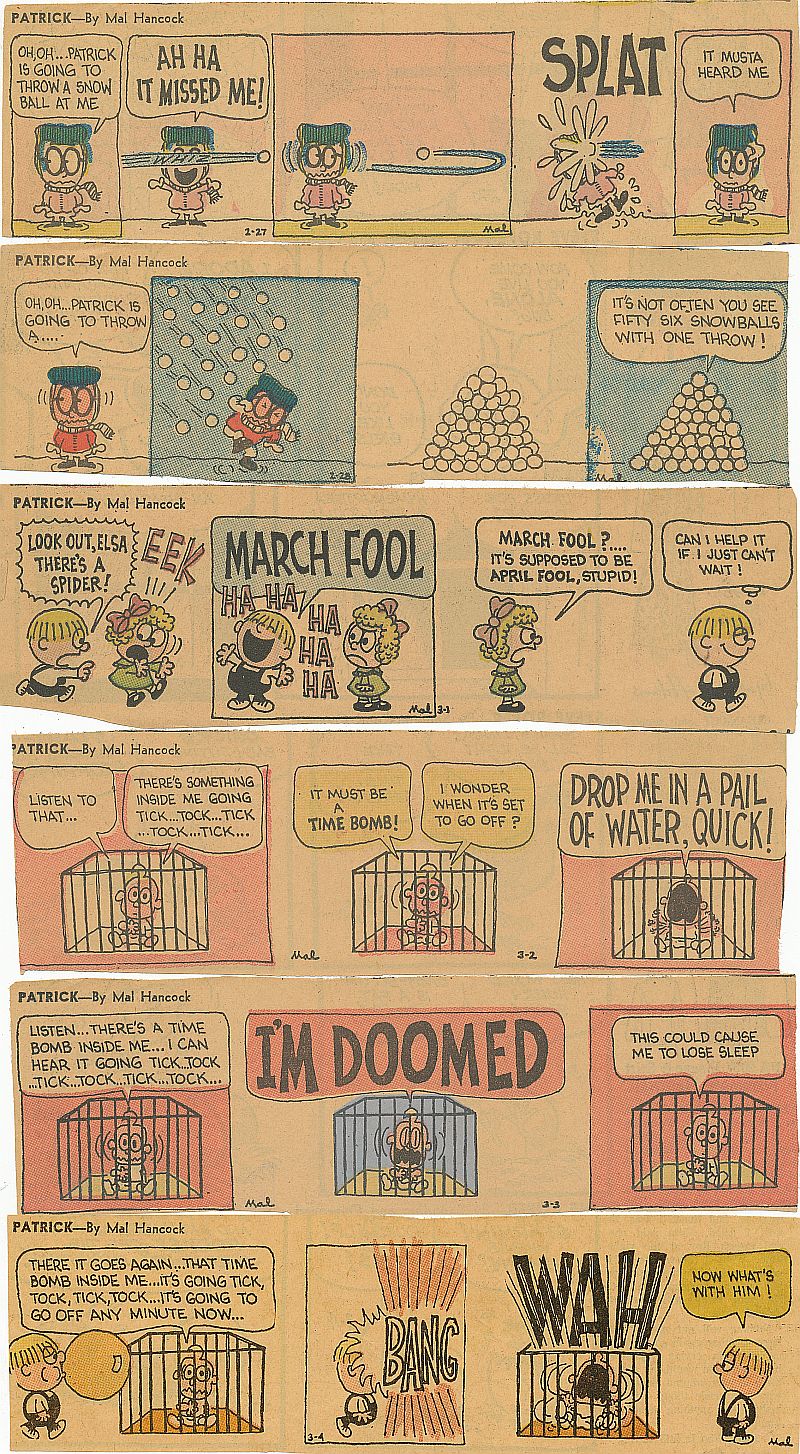 Patrick, from 2-27 to 3-4-1967, features gags with Godfrey, Elsa and Nathan. Nathan has half the strips, from 3-2 to 3-4, in which he is slowly going mad. Poor Nathan thinks there is a time bomb inside of him, and you can see the result of his hallucination in the 3-4. The strip is slowly starting to shift it’s focus to Nathan, perhaps Hancock found a baby confined in a playpen to be stimulating to his imagination. By the way, I’ll run out of Patrick strips in two more posts, but I have something rare to take his place. The next post should pop up on the 27th, the fifth anniversary of this foolish enterprise called a blog. We started March 27th, 2007. See you then!
Patrick, from 2-27 to 3-4-1967, features gags with Godfrey, Elsa and Nathan. Nathan has half the strips, from 3-2 to 3-4, in which he is slowly going mad. Poor Nathan thinks there is a time bomb inside of him, and you can see the result of his hallucination in the 3-4. The strip is slowly starting to shift it’s focus to Nathan, perhaps Hancock found a baby confined in a playpen to be stimulating to his imagination. By the way, I’ll run out of Patrick strips in two more posts, but I have something rare to take his place. The next post should pop up on the 27th, the fifth anniversary of this foolish enterprise called a blog. We started March 27th, 2007. See you then!
The Junior Times Marches On!


 Â Continuing our new series on the L.A. Junior Times from 1924, I found a Hardie Gramatky front page drawing called “Knight-Life on the Ark” published 3-16-1924. About 9 years later, in March of 1933, Hardie was animating on “Father Noah’s Ark” in Ben Sharpsteen’s unit at Walt Disney Productions, so here he was predicting his own future! Manuel Moreno was so well thought of by “Aunt Dolly” of the Junior Times Club, that he became the “official” club cartoonist! I’ve run three of his more interesting drawings from the 1924 Jr. Times, “Our Club in Cartoons” from June 22, dutifully promotes all the divisions of the Club, writing, cartooning, baseball, acting, humane works and member recruiting. What a club that must have been! Manuel did a lot of different drawings for the Jr. Times, some showing pretty girls in flowery outfits, some showing an idealized Aunt Dolly (leader of the Club), and then his own comic strips. I ran a couple of “Mr. Peach” pages last post, here is the first strip of an irregular series called “The Tuttlems” that ran 7-66-1924, and an episode of the series, “The Boy Who Wants To Know”, from 7-13-1924. The latter strip uses a very old joke that must go back to 1889, still in use as late as ’24. I’ll post more of these as I come across them.
 Continuing our new series on the L.A. Junior Times from 1924, I found a Hardie Gramatky front page drawing called “Knight-Life on the Ark” published 3-16-1924. About 9 years later, in March of 1933, Hardie was animating on “Father Noah’s Ark” in Ben Sharpsteen’s unit at Walt Disney Productions, so here he was predicting his own future! Manuel Moreno was so well thought of by “Aunt Dolly” of the Junior Times Club, that he became the “official” club cartoonist! I’ve run three of his more interesting drawings from the 1924 Jr. Times, “Our Club in Cartoons” from June 22, dutifully promotes all the divisions of the Club, writing, cartooning, baseball, acting, humane works and member recruiting. What a club that must have been! Manuel did a lot of different drawings for the Jr. Times, some showing pretty girls in flowery outfits, some showing an idealized Aunt Dolly (leader of the Club), and then his own comic strips. I ran a couple of “Mr. Peach” pages last post, here is the first strip of an irregular series called “The Tuttlems” that ran 7-66-1924, and an episode of the series, “The Boy Who Wants To Know”, from 7-13-1924. The latter strip uses a very old joke that must go back to 1889, still in use as late as ’24. I’ll post more of these as I come across them.













  In Barker Bill, from 2-7 to 2-20-1955, Peanuts Perkins’ mistake in mixing up costumes, leads Gorgonzola the Circus Gorilla to don Barker Bill’s extra tuxedo. The Boombar Gang catches Gorgonzola and believes him to be Barker Bill by the cut of his clothes and hat. Hatchet Head, one of the Gang’s minions, wants to run “Bill/Gorgonzola” for Mayor, believing the Gorilla can be easily controlled by the Boombars. Puddy, however, being the brains of the Circus, lures Gorgonzola back to the Circus using a beautiful Girl Gorilla for bait. In the Sunday page from 2-20, Puddy sings a little of “Beautiful You”, a song composed by Phil Scheib for the Terrytoon: “An Igloo For Two”, released in 1955, same year these strips were published. It’s interesting that Bob Kuwahara, who drew the Barker Bill strip, and Hardie Gramatky both animated on “Father Noah’s Ark” at Disney in 1933. Another animator in the Sharpsteen unit on “Father Noah’s Ark”, Tom Bonfiglio, was my first boss in animation in St. Louis when I was a kid. He trained me to do inbetweens and gave me cels in exchange for my “work”. He had changed his name to Tom Goodson by then. It’s interesting how everything hooks up eventually. Tom told me that the animators on “Father Noah’s Ark” were promised bonuses and other favors if they would work a lot of extra hours to finish all the “crowd” scenes with the Ark animals. All that they received for the moonlighting was fifty cents for a hash-house dinner, the bonuses never materialized.
 In Barker Bill, from 2-7 to 2-20-1955, Peanuts Perkins’ mistake in mixing up costumes, leads Gorgonzola the Circus Gorilla to don Barker Bill’s extra tuxedo. The Boombar Gang catches Gorgonzola and believes him to be Barker Bill by the cut of his clothes and hat. Hatchet Head, one of the Gang’s minions, wants to run “Bill/Gorgonzola” for Mayor, believing the Gorilla can be easily controlled by the Boombars. Puddy, however, being the brains of the Circus, lures Gorgonzola back to the Circus using a beautiful Girl Gorilla for bait. In the Sunday page from 2-20, Puddy sings a little of “Beautiful You”, a song composed by Phil Scheib for the Terrytoon: “An Igloo For Two”, released in 1955, same year these strips were published. It’s interesting that Bob Kuwahara, who drew the Barker Bill strip, and Hardie Gramatky both animated on “Father Noah’s Ark” at Disney in 1933. Another animator in the Sharpsteen unit on “Father Noah’s Ark”, Tom Bonfiglio, was my first boss in animation in St. Louis when I was a kid. He trained me to do inbetweens and gave me cels in exchange for my “work”. He had changed his name to Tom Goodson by then. It’s interesting how everything hooks up eventually. Tom told me that the animators on “Father Noah’s Ark” were promised bonuses and other favors if they would work a lot of extra hours to finish all the “crowd” scenes with the Ark animals. All that they received for the moonlighting was fifty cents for a hash-house dinner, the bonuses never materialized.






 Â In Felix, from 6-10 to 6-16-1935, Felix and the ship’s crew spend a week on the Ape’s Island being confused by a giant duck that swallowed the Captain’s two-way radio transmitter. The duck becomes terrified of the radio in his tummy and flies all over the island, mixing everybody up. In the Sunday page, Felix lures the subconscious mind of a skilled carpenter to Dreamland, to build a house for the elves, and we bid farewell to Laura, the first Felix “topper”. She concludes her 1927 to 1935 run by cussing a blue streak! Maybe that’s why she was fired?
 In Felix, from 6-10 to 6-16-1935, Felix and the ship’s crew spend a week on the Ape’s Island being confused by a giant duck that swallowed the Captain’s two-way radio transmitter. The duck becomes terrified of the radio in his tummy and flies all over the island, mixing everybody up. In the Sunday page, Felix lures the subconscious mind of a skilled carpenter to Dreamland, to build a house for the elves, and we bid farewell to Laura, the first Felix “topper”. She concludes her 1927 to 1935 run by cussing a blue streak! Maybe that’s why she was fired?





 A good six strip continuity is in Krazy this time, from 4-21 to 4-26-1941. Ignatz and Krazy take turns scaring each other with really zany masks that only Garge could draw. In the 4-26, Ignatz turns his talents to scaring a pachyderm; love those Herriman elephants!
A good six strip continuity is in Krazy this time, from 4-21 to 4-26-1941. Ignatz and Krazy take turns scaring each other with really zany masks that only Garge could draw. In the 4-26, Ignatz turns his talents to scaring a pachyderm; love those Herriman elephants!
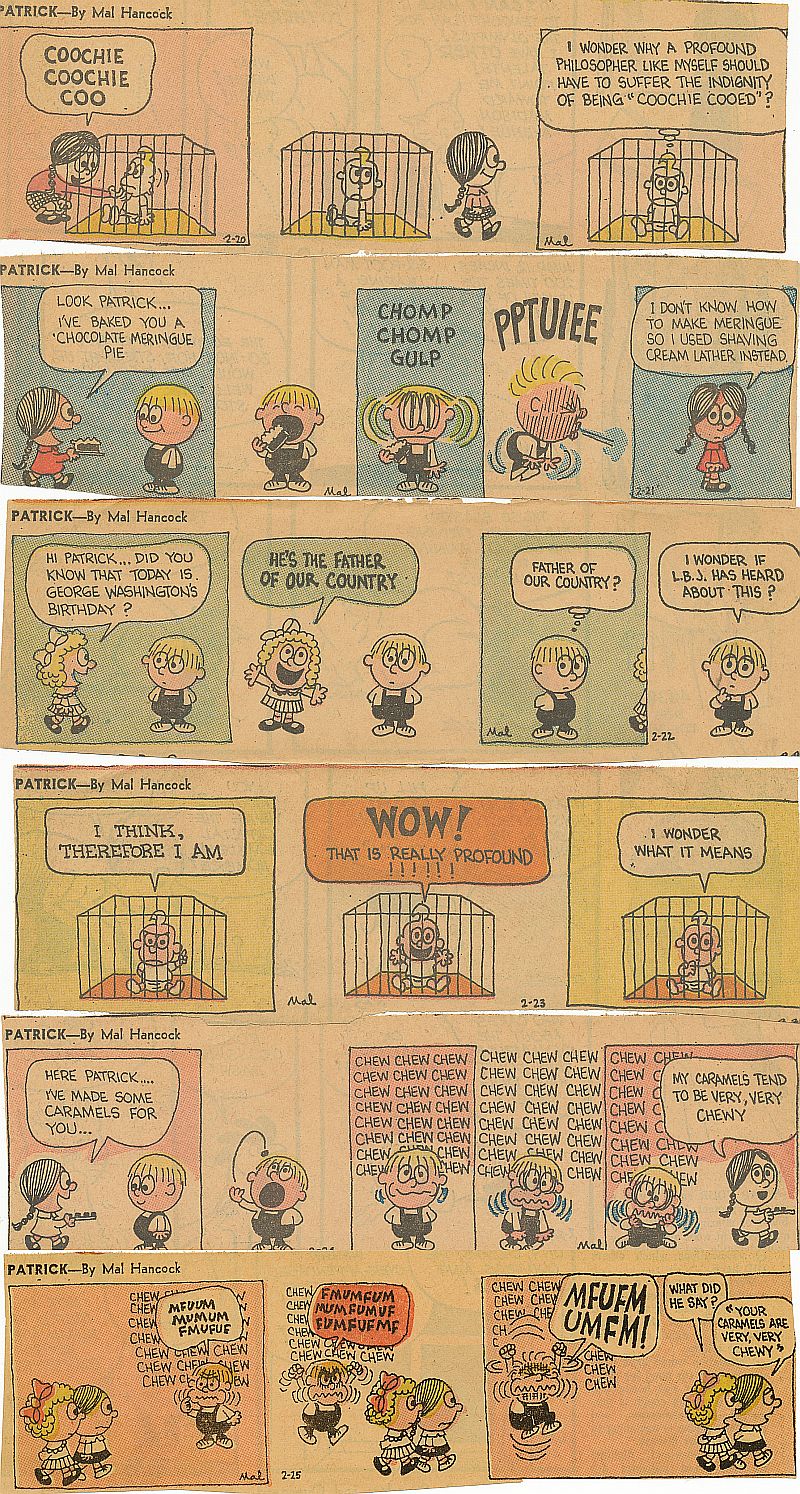 Â In Patrick, from 2-20 to 2-25-1967, little brother Nathan has the starring part in two strips, and Suzy’s meringue pie and “very chewy” caramels drive Patrick nuts! In the 2-22, a Washington’s birthday strip, Patrick refers to “L.B.J.”. To those of you who weren’t around then, that’s Lyndon Baines Johnson, President from 1963 to 1969, Patrick’s President!
 In Patrick, from 2-20 to 2-25-1967, little brother Nathan has the starring part in two strips, and Suzy’s meringue pie and “very chewy” caramels drive Patrick nuts! In the 2-22, a Washington’s birthday strip, Patrick refers to “L.B.J.”. To those of you who weren’t around then, that’s Lyndon Baines Johnson, President from 1963 to 1969, Patrick’s President!



 Â You know, if it weren’t for Yowp’s blog (see link to your right), I couldn’t start posting each month. The black and white Yogi Sunday pages he posts, spur me on to put up the color half-page versions. These ran 3/4, 3/11, 3/18 and 3/25/1962, and feature the work of Harvey Eisenberg (also an animator on “Father Noah’s Ark”-Just Kidding!), and others. I had some good news on “There Must Be Some Other Cat” this week, I’ll tell you more about it when I get some more definite info. Until the next time, when, possibly you all will tune in again…
 You know, if it weren’t for Yowp’s blog (see link to your right), I couldn’t start posting each month. The black and white Yogi Sunday pages he posts, spur me on to put up the color half-page versions. These ran 3/4, 3/11, 3/18 and 3/25/1962, and feature the work of Harvey Eisenberg (also an animator on “Father Noah’s Ark”-Just Kidding!), and others. I had some good news on “There Must Be Some Other Cat” this week, I’ll tell you more about it when I get some more definite info. Until the next time, when, possibly you all will tune in again…
Introducing the The Junior Times from 1922-1923!
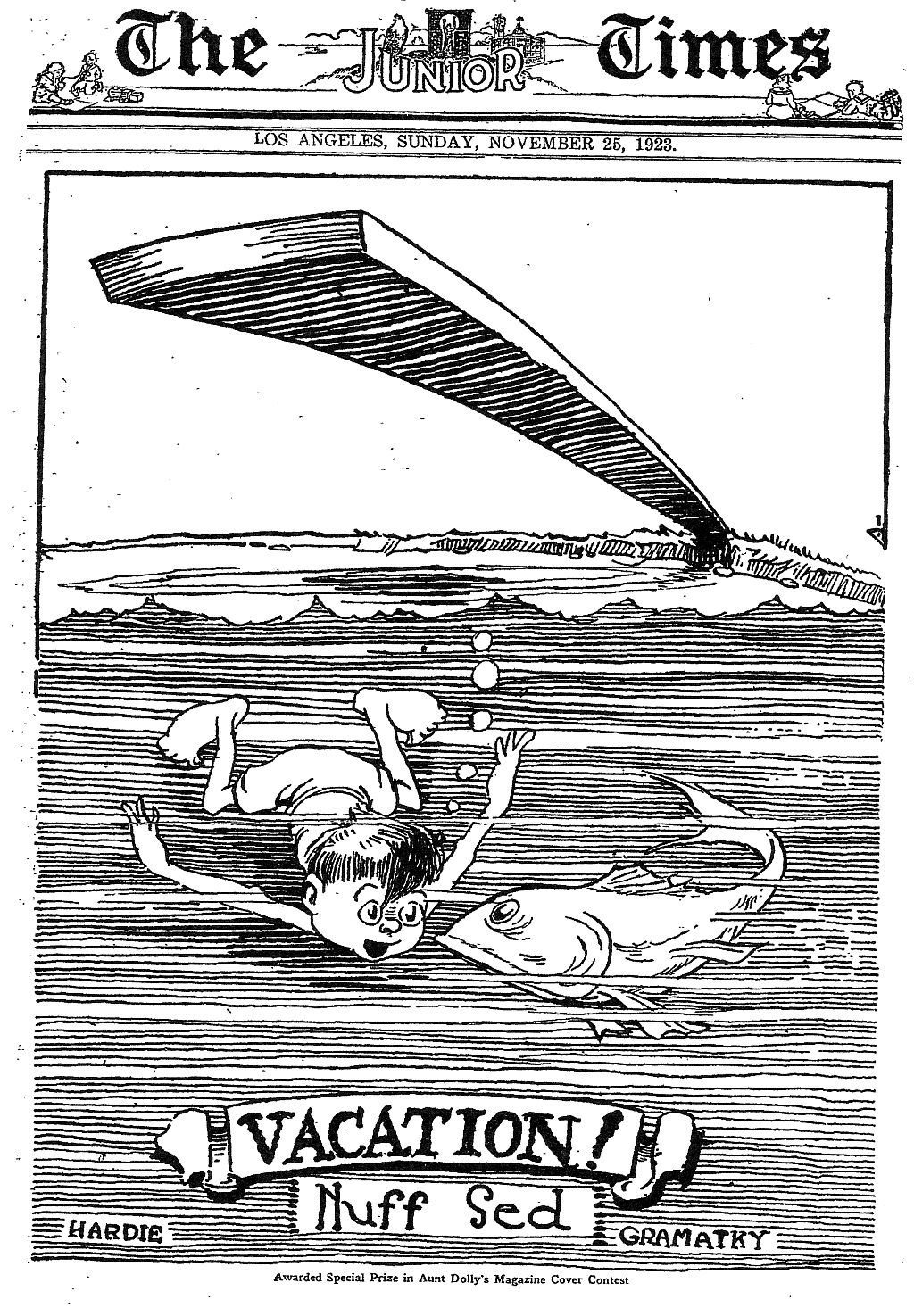 There isn’t much information around the ‘net about “The Junior Times”, the 8 page little tabloid Sunday supplement for children, started as a supplement to the Los Angeles Sunday Times on July 23, 1922. Here is the announcement of the little paper, advertised on the front page of the Los Angeles Times:
There isn’t much information around the ‘net about “The Junior Times”, the 8 page little tabloid Sunday supplement for children, started as a supplement to the Los Angeles Sunday Times on July 23, 1922. Here is the announcement of the little paper, advertised on the front page of the Los Angeles Times: 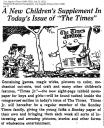  The paper started out a lot like a miniature “St. Nicholas” magazine, reprinting some of the Chicago Tribune’s kid-skewing features like “The Teeny-Weenies” and obscure comic strips like “Just Dog” by Robert Dickey and “Buttons and Fatty” by a cartoonist named “Meb”. It wasn’t until Sept. 9th, 1923 that “Aunt Dolly”‘s interactive pages for children started. The mysterious Aunt encouraged poetry, fiction, art and photography from her young readers and got a good response. Among the earliest contributors were Manuel M. Moreno, who was an animation pioneer working with Walter Lantz as early as 1930:
 The paper started out a lot like a miniature “St. Nicholas” magazine, reprinting some of the Chicago Tribune’s kid-skewing features like “The Teeny-Weenies” and obscure comic strips like “Just Dog” by Robert Dickey and “Buttons and Fatty” by a cartoonist named “Meb”. It wasn’t until Sept. 9th, 1923 that “Aunt Dolly”‘s interactive pages for children started. The mysterious Aunt encouraged poetry, fiction, art and photography from her young readers and got a good response. Among the earliest contributors were Manuel M. Moreno, who was an animation pioneer working with Walter Lantz as early as 1930: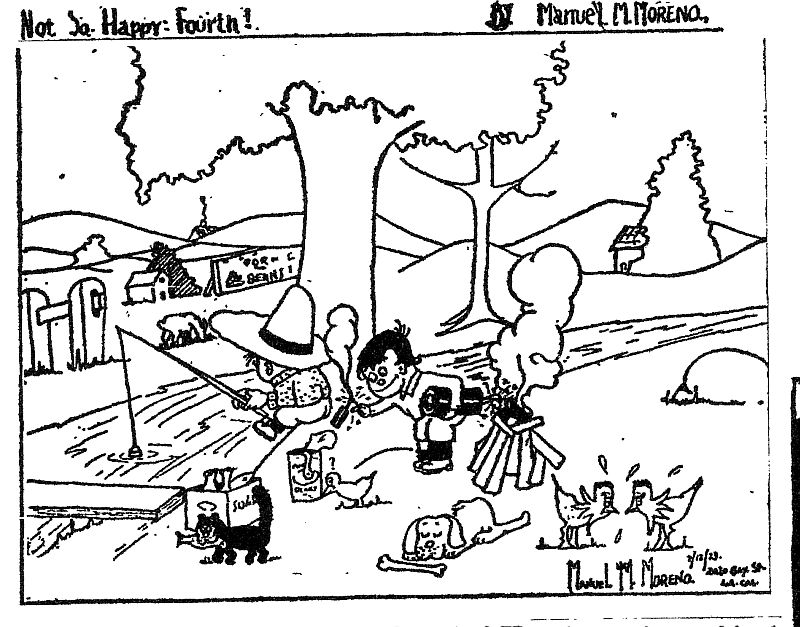 This little drawing, “Not So Happy Fourth” from 9-9-1923, is the earliest one I could find in the Jr. Times. Manuel developed a cuter Oswald the Rabbit for Walter Lantz while he worked there, he had a more appealing and controlled approach to his animation than the usual standard at Lantz. As a child, he figured prominently in the 1923 Aunt Dolly Christmas Party: “Speaking of Toy-Makers reminds me of the good news concerning our talented cartoonist, Manuel K. (sic) Moreno. He is making a meteorlike career for himself. First capturing a Kodak as a prize, then receiving a special $5 cash prize in addition for exceptional Toy-Maker work. But not content with such honors, he has become a captain of our famous club, thereby winning another prize. Now just when Aunt Dolly was writing his order for a $2.50 check, in he has come with two bulging parcels under his arm. ‘For the Toy-Makers,’ he said, with his ready smile, ‘I hope they will make some little boy and girl happy.’ It is needless to say that The Times committee of happiness was surprised when they looked down on his clever pivoting toys, a cat that humps his back, raises it’s tail and rolls it’s eyes at you, a football player carved and painted, that throws a ball like a bluestreak, and a clown that opens his mouth and makes grimaces at you.” (by Aunt Dolly, 12-2-1923) Note the early penchant for animation in Moreno’s early toys! I certainly wish I could see pictures of those toys, especially the cat! Here are two episodes of Manuel’s early comic strip for the Jr. Times, called “Mr. Peach”:
This little drawing, “Not So Happy Fourth” from 9-9-1923, is the earliest one I could find in the Jr. Times. Manuel developed a cuter Oswald the Rabbit for Walter Lantz while he worked there, he had a more appealing and controlled approach to his animation than the usual standard at Lantz. As a child, he figured prominently in the 1923 Aunt Dolly Christmas Party: “Speaking of Toy-Makers reminds me of the good news concerning our talented cartoonist, Manuel K. (sic)Â Moreno. He is making a meteorlike career for himself. First capturing a Kodak as a prize, then receiving a special $5 cash prize in addition for exceptional Toy-Maker work. But not content with such honors, he has become a captain of our famous club, thereby winning another prize. Now just when Aunt Dolly was writing his order for a $2.50 check, in he has come with two bulging parcels under his arm. ‘For the Toy-Makers,’ he said, with his ready smile, ‘I hope they will make some little boy and girl happy.’ It is needless to say that The Times committee of happiness was surprised when they looked down on his clever pivoting toys, a cat that humps his back, raises it’s tail and rolls it’s eyes at you, a football player carved and painted, that throws a ball like a bluestreak, and a clown that opens his mouth and makes grimaces at you.” (by Aunt Dolly, 12-2-1923) Note the early penchant for animation in Moreno’s early toys! I certainly wish I could see pictures of those toys, especially the cat! Here are two episodes of Manuel’s early comic strip for the Jr. Times, called “Mr. Peach”: 
 Â These are from Oct. and Dec., 1923 and are among the earliest child-contributed comic strips I found in the Jr. Times. I also found an early drawing by Bob Wickersham:
 These are from Oct. and Dec., 1923 and are among the earliest child-contributed comic strips I found in the Jr. Times. I also found an early drawing by Bob Wickersham:   from 9-16-1923, and Cal Howard:
 from 9-16-1923, and Cal Howard:   Nov. 11, 1923. I’m sure both these boys are well-known to animation fans, Wickersham for his animation at Disney’s and Screen Gems, where he was the main contributor to the “Fox and Crow” cartoons, and Cal Howard, animator for Walter Lantz, who became a key gag and story creator in the golden age, contributing stories to Lantz almost right up to 1972. Thanks to the Glendale Library’s subscription to the vintage L.A. Times, I can search the 1920s papers without loading any microfilm into readers, all the material is right here on the ‘net. The “Vacation, ‘Nuff Sed” cover drawing above is by Hardie Gramatky, future creator of “Little Toot” and pioneer Disney animator, as well as one of the finest California watercolorists. He was one of John Bohnenberger’s idols as related in a previous post. Hardie’s mother, and brother Herbert both contributed to Aunt Dolly’s contests as well in 1923. It must have helped Hardie to come from such an artistic family, look what he did with his heritage! I’ll try to find more material from “The Junior Times” as we go along. Such kids as Fred Moore contributed some comics to the Junior Times later on, as we’ll see.
 Nov. 11, 1923. I’m sure both these boys are well-known to animation fans, Wickersham for his animation at Disney’s and Screen Gems, where he was the main contributor to the “Fox and Crow” cartoons, and Cal Howard, animator for Walter Lantz, who became a key gag and story creator in the golden age, contributing stories to Lantz almost right up to 1972. Thanks to the Glendale Library’s subscription to the vintage L.A. Times, I can search the 1920s papers without loading any microfilm into readers, all the material is right here on the ‘net. The “Vacation, ‘Nuff Sed” cover drawing above is by Hardie Gramatky, future creator of “Little Toot” and pioneer Disney animator, as well as one of the finest California watercolorists. He was one of John Bohnenberger’s idols as related in a previous post. Hardie’s mother, and brother Herbert both contributed to Aunt Dolly’s contests as well in 1923. It must have helped Hardie to come from such an artistic family, look what he did with his heritage! I’ll try to find more material from “The Junior Times” as we go along. Such kids as Fred Moore contributed some comics to the Junior Times later on, as we’ll see.












  Barker Bill is from 1-24 to 2-6-1955 this time. The circus is still travelling, with many gags featuring the Fat Lady, Phyllis Fizeek and May, her niece, Elephants, a Giraffe and of course, Peanut Perkins, the resident dumb roustabout. Perkins is even in the Sunday page from the Boston Globe. A mix-up in deliveries to the tailor and the Gorilla by Peanut, set up the next batch of continuity gags in the Barker Bill strip.
 Barker Bill is from 1-24 to 2-6-1955 this time. The circus is still travelling, with many gags featuring the Fat Lady, Phyllis Fizeek and May, her niece, Elephants, a Giraffe and of course, Peanut Perkins, the resident dumb roustabout. Perkins is even in the Sunday page from the Boston Globe. A mix-up in deliveries to the tailor and the Gorilla by Peanut, set up the next batch of continuity gags in the Barker Bill strip.






 Â Felix from 6-3 to 6-9-1935 continues the Gorilla Island story. It’s uncanny how such a cartoony style as Messmer’s can create scary monster animals, such as the ones in 6-6 and 6-8 episodes. The giant duck introduced in the 6-8 figures in the story to a great extent later on. The Giant making a pipe out of an elf’s house in the Sunday page, reminds me of some of the gags in “The Brave Little Tailor”, a Mickey Mouse cartoon from 1938. Messmer did them first!
 Felix from 6-3 to 6-9-1935 continues the Gorilla Island story. It’s uncanny how such a cartoony style as Messmer’s can create scary monster animals, such as the ones in 6-6 and 6-8 episodes. The giant duck introduced in the 6-8 figures in the story to a great extent later on. The Giant making a pipe out of an elf’s house in the Sunday page, reminds me of some of the gags in “The Brave Little Tailor”, a Mickey Mouse cartoon from 1938. Messmer did them first!





 Â Krazy this time is from 4-14 to 4-19-1941. The continuity lasts all week and involves two trees, Offissa Pupp and Ignatz as the principal elements. The last two strips feature a talking brick. The key weapon in the strip has become a character.
 Krazy this time is from 4-14 to 4-19-1941. The continuity lasts all week and involves two trees, Offissa Pupp and Ignatz as the principal elements. The last two strips feature a talking brick. The key weapon in the strip has become a character.
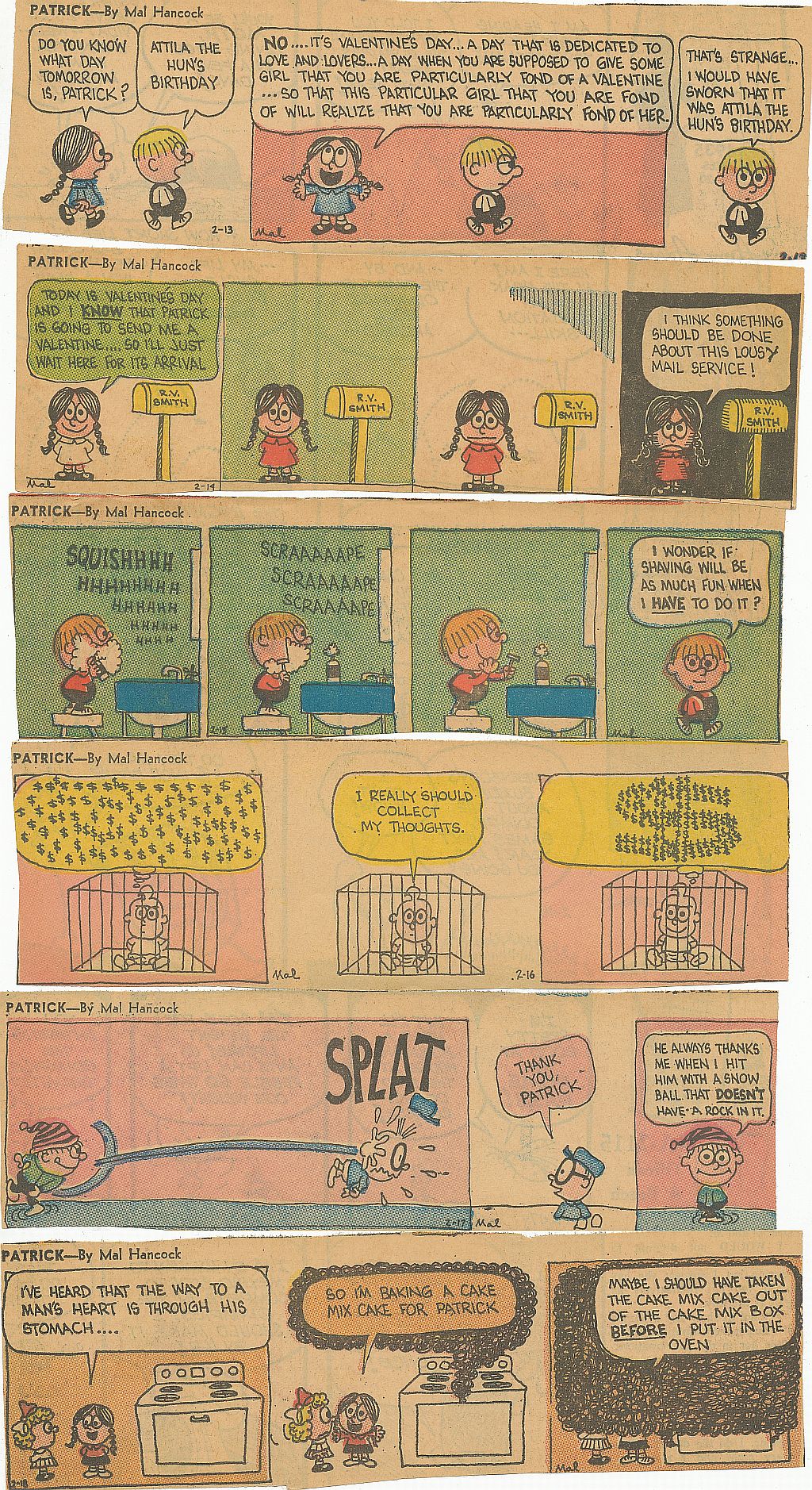 Patrick, from 2-13 to 2-18-1967, concludes our little screed this time. Suzy is the featured supporting player this week, trying to get a valentine out of Patrick and trying to appeal to his stomach with a cake. Patrick believes that St. Valentine’s day is actually Attila the Hun’s birthday. Sounds like an appropriate hero for the horrible little brat.
Patrick, from 2-13 to 2-18-1967, concludes our little screed this time. Suzy is the featured supporting player this week, trying to get a valentine out of Patrick and trying to appeal to his stomach with a cake. Patrick believes that St. Valentine’s day is actually Attila the Hun’s birthday. Sounds like an appropriate hero for the horrible little brat.
If any of you historians out there can contribute some info. to the “Junior Times” series, drop me a line. It will be a welcome relief from all the mail I get in Russian and the strange offers of Faster Computer Speeds which usually originate from Gmail addresses. Cut it out you guys, or I’ll give you such a pinch!
Strips












 Â The response to the John Bohnenberger posts weren’t too much, but that’s understandable. The computer savvy are too young, and the folks who knew John are mostly computer illiterate. I’ll just post some comics this time, starting with Barker Bill from 1-10 to 1-22-1955. The gags all feature the side-show freaks like the tall man, the fat lady and Phyllis Fezeek, the strong woman. Her little niece May figures in some of these. Peanuts Perkins, roustabout and all-around dumb guy is good for a few jokes as well.
 The response to the John Bohnenberger posts weren’t too much, but that’s understandable. The computer savvy are too young, and the folks who knew John are mostly computer illiterate. I’ll just post some comics this time, starting with Barker Bill from 1-10 to 1-22-1955. The gags all feature the side-show freaks like the tall man, the fat lady and Phyllis Fezeek, the strong woman. Her little niece May figures in some of these. Peanuts Perkins, roustabout and all-around dumb guy is good for a few jokes as well.






  I echo the elve’s comment in the last panel of the Felix Sunday page, “What would we do without Felix?” Here’s Felix from 5-27 to 6-2-1935. He’s still on the Ape’s island with Danny and the explorers from the ship. Mostly insect and strange animals populate the tropical paradise in this batch of strips. I love the pose in the last panel of the 6-1, as Felix happily dozes after subduing a horned beast with a brace of melons. I love the change of character in the “Laura” topper, as she becomes less of a pest, and more of a homeless parrot in need of love.
 I echo the elve’s comment in the last panel of the Felix Sunday page, “What would we do without Felix?” Here’s Felix from 5-27 to 6-2-1935. He’s still on the Ape’s island with Danny and the explorers from the ship. Mostly insect and strange animals populate the tropical paradise in this batch of strips. I love the pose in the last panel of the 6-1, as Felix happily dozes after subduing a horned beast with a brace of melons. I love the change of character in the “Laura” topper, as she becomes less of a pest, and more of a homeless parrot in need of love.





 Â Krazy, from 4-7 to 4-12-1941, starts off with an iconic Ignatz strip in which he is “Hunted, Haunted and Hounded” as we all are, by the threat of incarceration. There are also a couple of little two-day continuities featuring Offissa Pupp fishing for Ignatz with a fishing pole baited with brick, and Krazy and Pupp sailing down the river in a box.
 Krazy, from 4-7 to 4-12-1941, starts off with an iconic Ignatz strip in which he is “Hunted, Haunted and Hounded” as we all are, by the threat of incarceration. There are also a couple of little two-day continuities featuring Offissa Pupp fishing for Ignatz with a fishing pole baited with brick, and Krazy and Pupp sailing down the river in a box.
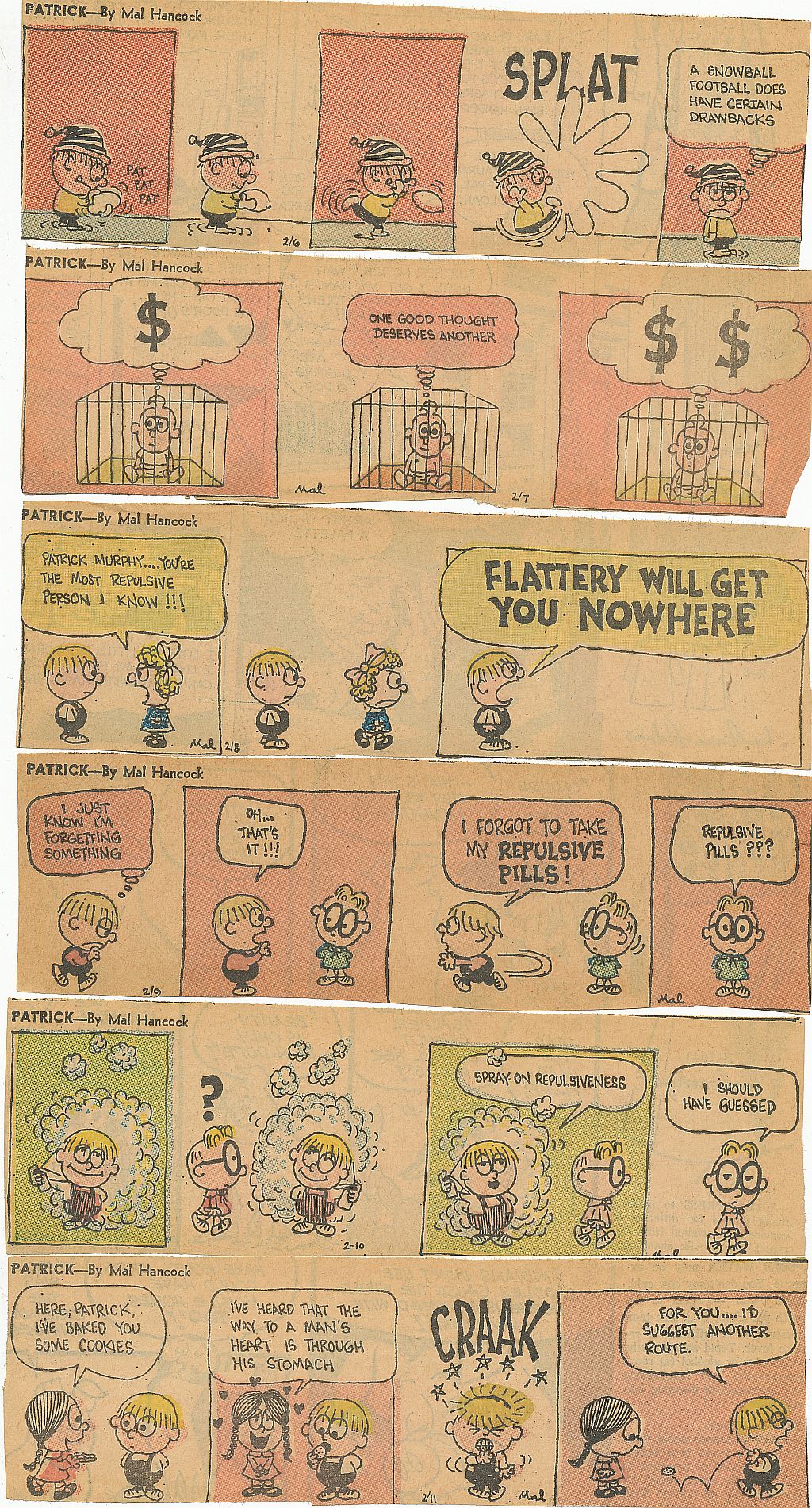  Here’s Patrick, 2-6 to 2-11-1967. Patrick gets his repulsiveness from pills and sprays, and poor Suzy can’t bake her way into Patrick’s very hard heart with her concrete cookies in the 2-11. Well, I’m gonna keep my head down and keep puttin’ up these crazy strips til’ y’all beg for mercy! See you next post.
 Here’s Patrick, 2-6 to 2-11-1967. Patrick gets his repulsiveness from pills and sprays, and poor Suzy can’t bake her way into Patrick’s very hard heart with her concrete cookies in the 2-11. Well, I’m gonna keep my head down and keep puttin’ up these crazy strips til’ y’all beg for mercy! See you next post.
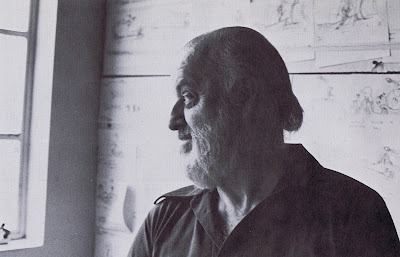




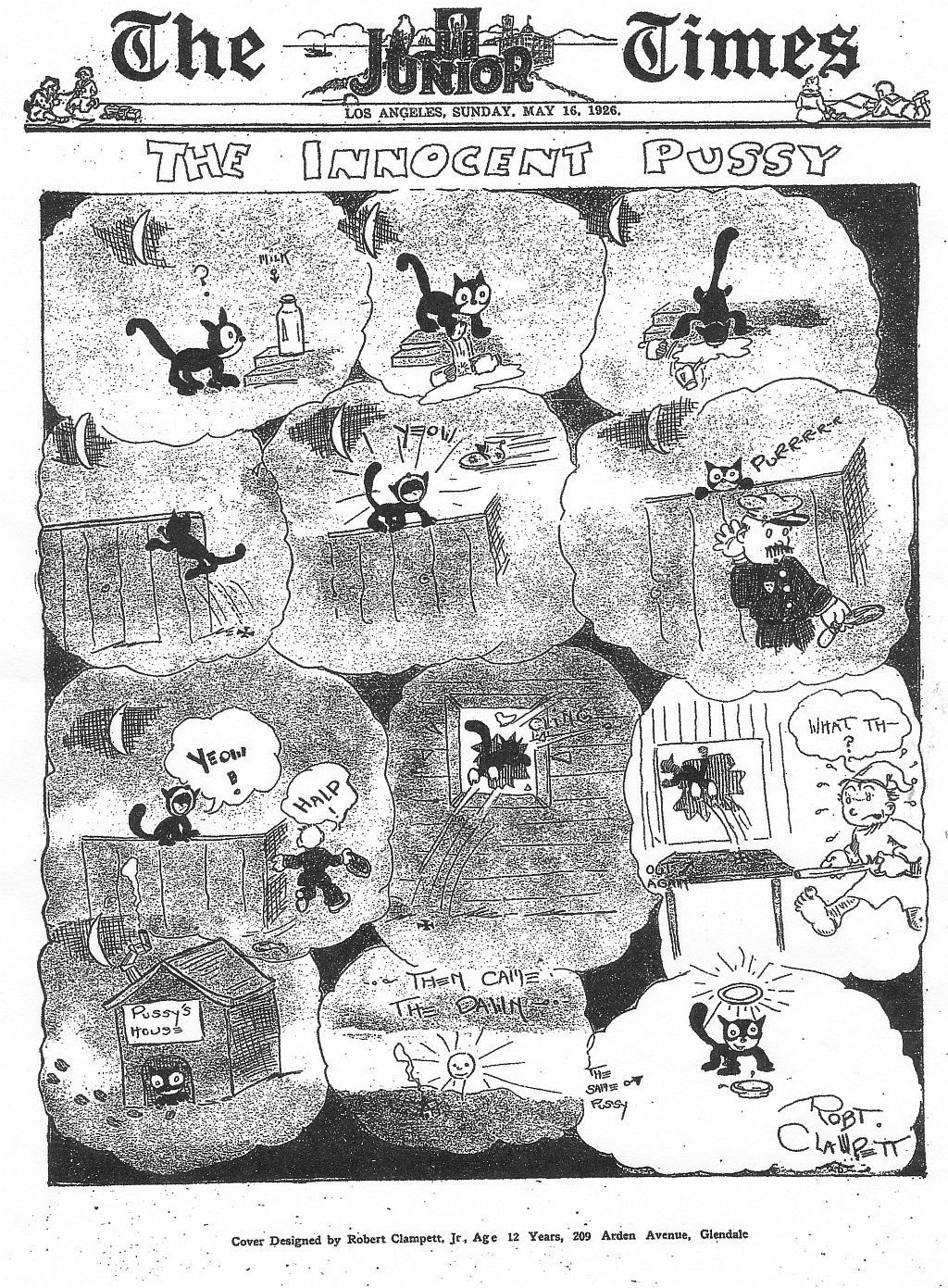






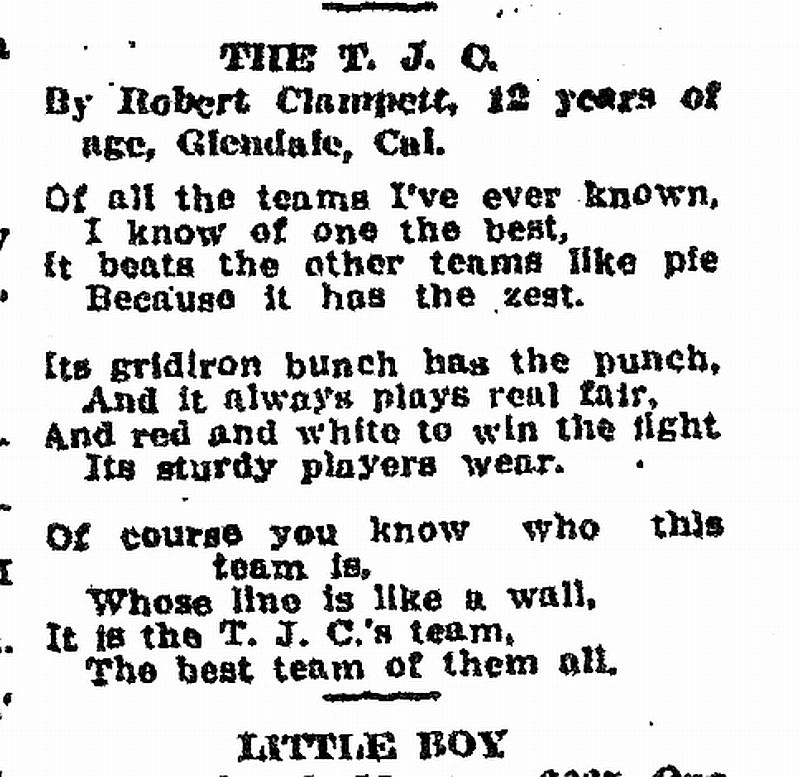












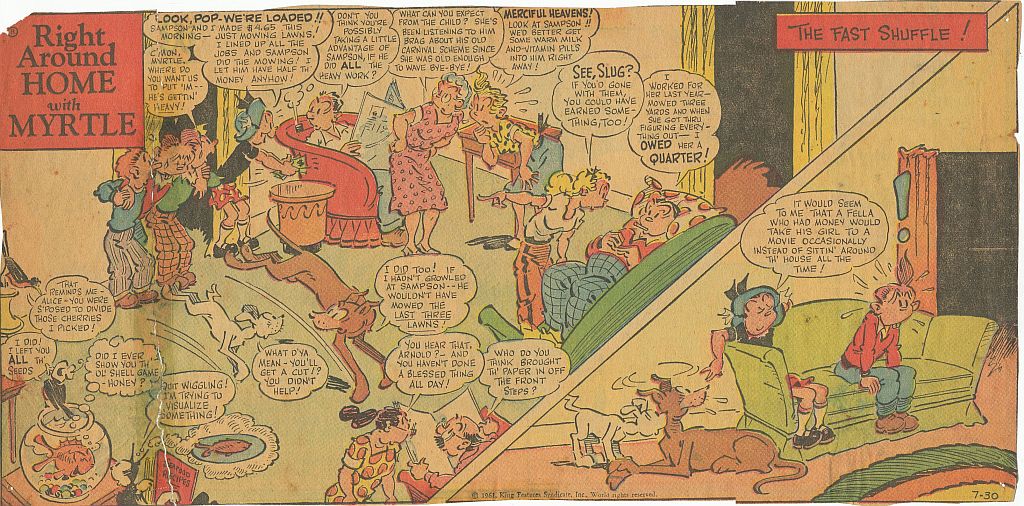
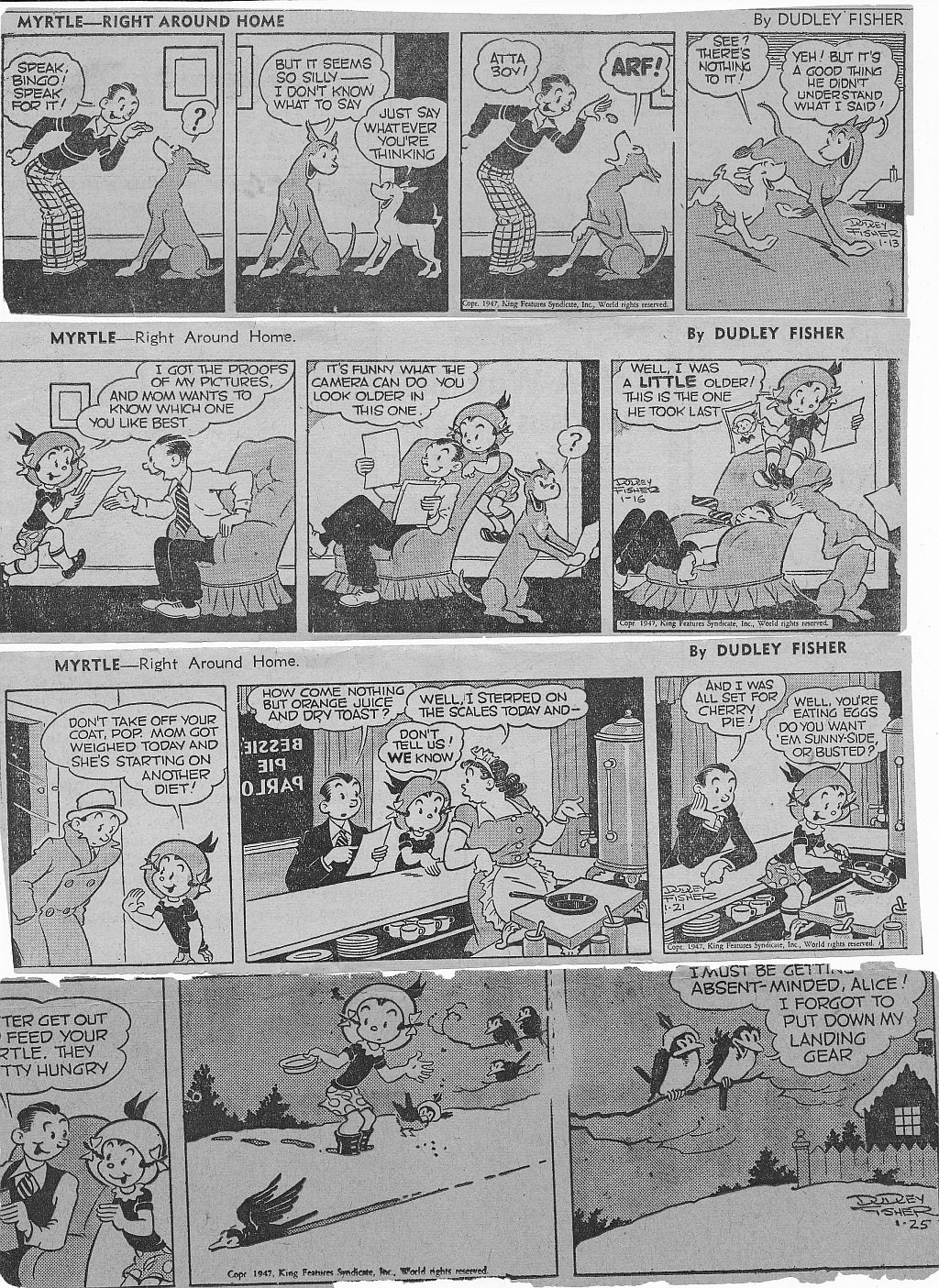





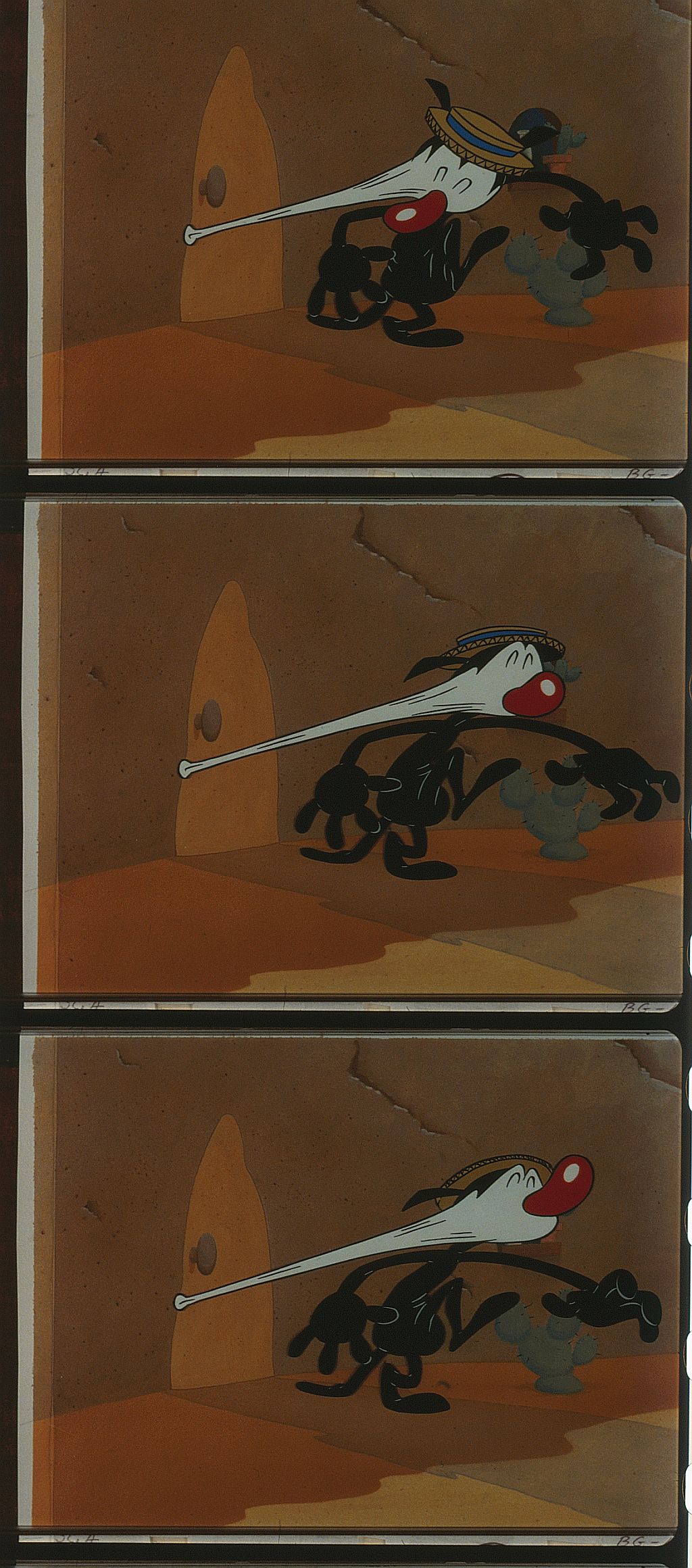
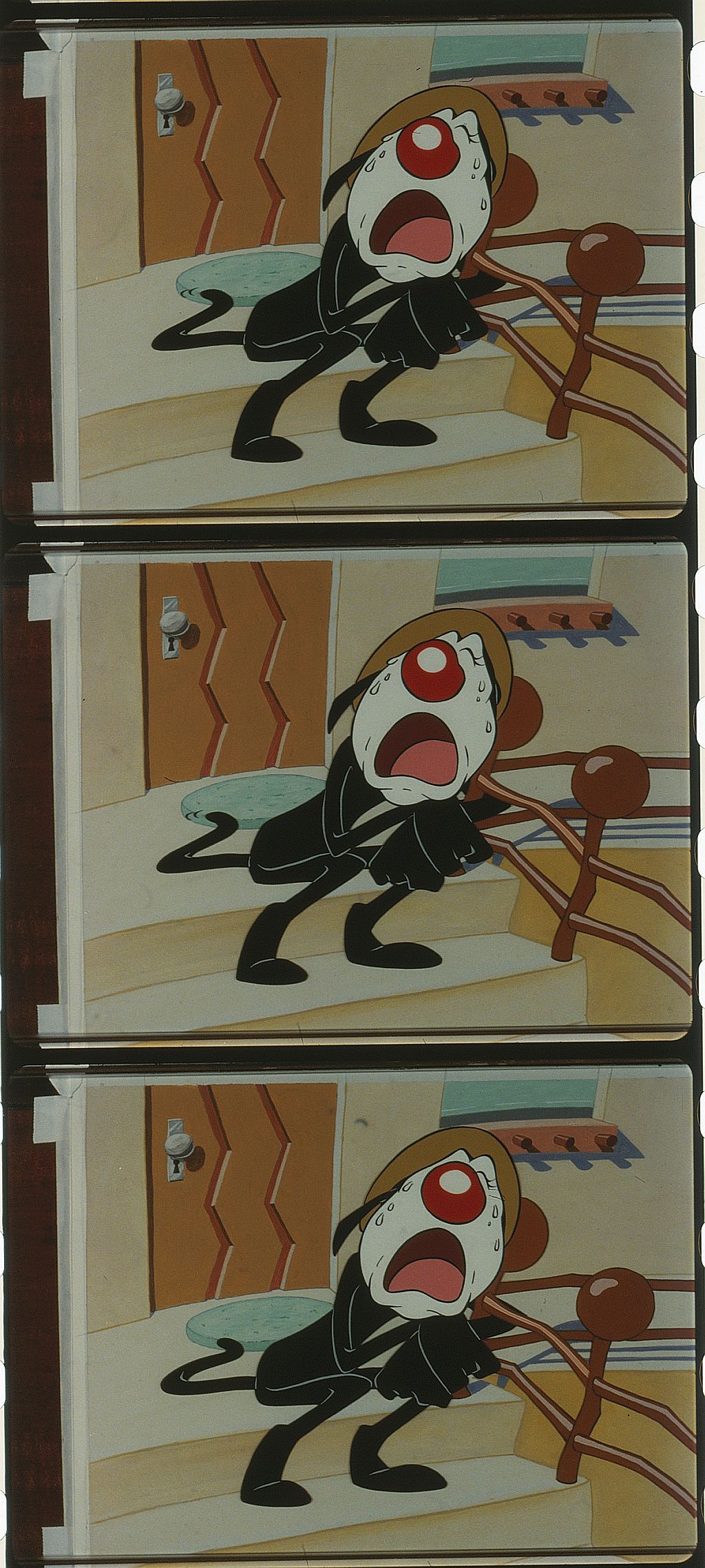


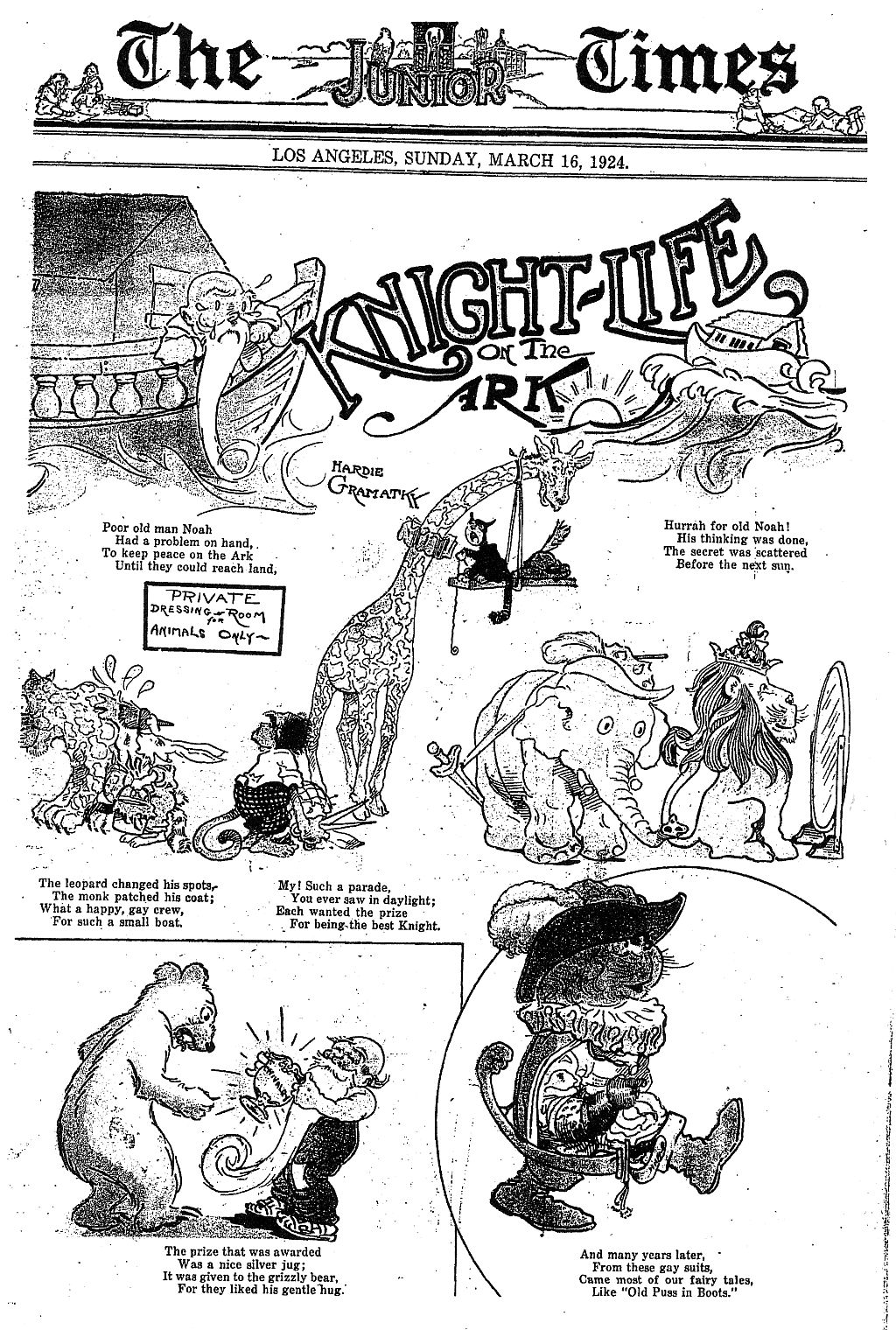
Stripz
July 22, 2012
Uncategorized
2 Comments
Mark